Users Manual

www.htc.com
HTC Magic
User Manual
2
Please Read Before Proceeding
THE BATTERY IS NOT CHARGED WHEN YOU TAKE IT OUT OF THE BOX.
DO NOT REMOVE THE BATTERY PACK WHEN THE DEVICE IS CHARGING.
YOUR WARRANTY IS INVALIDATED IF YOU OPEN OR TAMPER WITH THE
DEVICE’S OUTER CASING.
PRIVACY RESTRICTIONS
Some countries require full disclosure of recorded telephone conversations, and
stipulate that you must inform the person with whom you are speaking that the
conversation is being recorded. Always obey the relevant laws and regulations of
your country when using the recording feature of your device.
INTELLECTUAL PROPERTY RIGHT INFORMATION
Copyright © 2008 HTC Corporation. All Rights Reserved.
HTC, the HTC logo, HTC Magic, ExtUSB, HTC Innovation and HTC Care are
trademarks and/or service marks of HTC Corporation.
Copyright © 2009 Google Inc. Used with permission.
Google, the Google logo, Android, the Android logo, Android Market, Gmail, Google
Mail, Google Apps, Google Calendar, Google Checkout, Google Earth, Google
Latitude, Google Maps, Google Talk, Picasa, and YouTube are trademarks of Google
Inc.
Microsoft, Windows, Windows XP, Windows Vista, and Outlook are either registered
trademarks or trademarks of Microsoft Corporation in the United States and/or
other countries.
Bluetooth and the Bluetooth logo are trademarks owned by Bluetooth SIG, Inc.
microSD is a trademark of SD Card Association.
3
Licensed by QUALCOMM Incorporated under one or more of the following patents:
4,901,307 5,490,165 5,056,109 5,504,773 5,101,501 5,778,338
5,506,865 5,109,390 5,511,073 5,228,054 5,535,239 5,710,784
5,267,261 5,544,196 5,267,262 5,568,483 5,337,338 5,659,569
5,600,754 5,414,796 5,657,420 5,416,797
All other company, product and service names mentioned herein are trademarks,
registered trademarks or service marks of their respective owners.
HTC shall not be liable for technical or editorial errors or omissions contained
herein, nor for incidental or consequential damages resulting from furnishing this
material. The information is provided “as is” without warranty of any kind and is
subject to change without notice. HTC also reserves the right to revise the content
of this document at any time without prior notice.
No part of this document may be reproduced or transmitted in any form or by any
means, electronic or mechanical, including photocopying, recording or storing in a
retrieval system, or translated into any language in any form without prior written
permission of HTC.
Limitation of Damages
TO THE MAXIMUM EXTENT PERMITTED BY APPLICABLE LAW, IN NO EVENT SHALL
HTC OR ITS PROVIDERS BE LIABLE TO USER OR ANY THIRD PARTY FOR ANY
INDIRECT, SPECIAL, CONSEQUENTIAL, INCIDENTAL OR PUNITIVE DAMAGES OF ANY
KIND, IN CONTRACT OR TORT, INCLUDING, BUT NOT LIMITED TO, INJURY, LOSS OF
REVENUE, LOSS OF GOODWILL, LOSS OF BUSINESS OPPORTUNITY, LOSS OF DATA,
AND/OR LOSS OF PROFITS ARISING OUT OF, OR RELATED TO, IN ANY MANNER,
OR THE DELIVERY, PERFORMANCE OR NONPERFORMANCE OF OBLIGATIONS, OR
USE OF THE WEATHER INFORMATION, DATA OR DOCUMENTATION HEREUNDER
REGARDLESS OF THE FORESEEABILITY THEREOF.
4
Important Health Information and Safety Precautions
When using this product, the safety precautions below must be taken to avoid
possible legal liabilities and damages.
Retain and follow all product safety and operating instructions. Observe all
warnings in the operating instructions on the product.
To reduce the risk of bodily injury, electric shock, fire, and damage to the
equipment, observe the following precautions.
ELECTRICAL SAFETY
This product is intended for use when supplied with power from the designated
battery or power supply unit. Other usage may be dangerous and will invalidate
any approval given to this product.
SAFETY PRECAUTIONS FOR PROPER GROUNDING INSTALLATION
CAUTION: Connecting to an improperly grounded equipment can result in an
electric shock to your device.
This product equipped with a USB Cable for connecting with desktop or notebook
computer. Be sure your computer is properly grounded (earthed) before
connecting this product to the computer. The power supply cord of a desktop or
notebook computer has an equipment-grounding conductor and a grounding
plug. The plug must be plugged into an appropriate outlet which is properly
installed and grounded in accordance with all local codes and ordinances.
SAFETY PRECAUTIONS FOR POWER SUPPLY UNIT
• Use the correct external power source
A product should be operated only from the type of power source indicated
on the electrical ratings label. If you are not sure of the type of power source
required, consult your authorized service provider or local power company.
For a product that operates from battery power or other sources, refer to the
operating instructions that are included with the product.
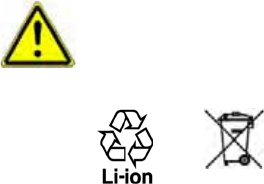
5
This product should be operated only with the following designated power
supply unit(s).
AC Adapter
Phihong, Models PSAA05A-050, PSAA05C-050, PSAA05E-050, PSAA05K-
050 and PSAA05S-050.
HTC, Model TC P300
Car Adapter
Phihong, Model CLA05D-050
• Handle battery packs carefully
This product contains a Li-ion polymer battery. There is a risk of fire and
burns if the battery pack is handled improperly. Do not attempt to open or
service the battery pack. Do not disassemble, crush, puncture, short external
contacts or circuits, dispose of in fire or water, or expose a battery pack to
temperatures higher than 60˚C (140˚F).
WARNING: Danger of explosion if battery is incorrectly replaced. To reduce risk
of fire or burns, do not disassemble, crush, puncture, short external contacts,
expose to temperature above 60° C (140° F), or dispose of in fire or water.
Replace only with specified batteries. Recycle or dispose of used batteries
according to the local regulations or reference guide supplied with your
product.
NOTE This product should be operated only with the following designated Battery
Pack(s). HTC, Model SAPP160
•
•
6
• Take extra precautions
•Keep the battery or device dry and away from water or any liquid as it may
cause a short circuit.
•Keep metal objects away so they don’t come in contact with the battery or
its connectors as it may lead to short circuit during operation.
•The phone should be only connected to products that bear the USB-IF
logo or have completed the USB-IF compliance program.
•Do not use a battery that appears damaged, deformed, or discoloured, or
the one that has any rust on its casing, overheats, or emits a foul odour.
•Always keep the battery out of the reach of babies and small children, to
avoid swallowing of the battery. Consult the doctor immediately if the
battery is swallowed.
•If the battery leaks:
•Do not allow the leaking fluid to come in contact with skin or clothing.
If already in contact, flush the affected area immediately with clean
water and seek medical advice.
•Do not allow the leaking fluid to come in contact with eyes. If already
in contact, DO NOT rub; rinse with clean water immediately and seek
medical advice.
•Take extra precautions to keep a leaking battery away from fire as
there is a danger of ignition or explosion.
SAFETY PRECAUTIONS FOR DIRECT SUNLIGHT
Keep this product away from excessive moisture and extreme temperatures. Do not
leave the product or its battery inside a vehicle or in places where the temperature
may exceed 60°C (140°F), such as on a car dashboard, window sill, or behind a glass
that is exposed to direct sunlight or strong ultraviolet light for extended periods
of time. This may damage the product, overheat the battery, or pose a risk to the
vehicle.

7
PREVENTION OF HEARING LOSS
CAUTION: Permanent hearing loss may occur if earphones or
headphones are used at high volume for prolonged periods of time.
NOTE: For France, Earphone (listed below) for this device have been tested to comply
with the Sound Pressure Level requirement laid down in the applicable NF EN 50332-
1:2000 and/or NF EN 50332-2:2003 standards as required by French Article L. 5232-1.
•Earphone, manufactured by Cotron, Model HS S200.
SAFETY IN AIRCRAFT
Due to the possible interference caused by this product to an aircraft’s navigation
system and its communications network, using this device’s phone function on
board an airplane is against the law in most countries. If you want to use this
device when on board an aircraft, remember to turn off your phone by switching to
Airplane Mode.
ENVIRONMENT RESTRICTIONS
Do not use this product in gas stations, fuel depots, chemical plants or where
blasting operations are in progress, or in potentially explosive atmospheres such
as fuelling areas, fuel storehouses, below deck on boats, chemical plants, fuel or
chemical transfer or storage facilities, and areas where the air contains chemicals or
particles, such as grain, dust, or metal powders. Please be aware that sparks in such
areas could cause an explosion or fire resulting in bodily injury or even death.
EXPLOSIVE ATMOSPHERES
When in any area with a potentially explosive atmosphere or where flammable
materials exist, the product should be turned off and the user should obey all signs
and instructions. Sparks in such areas could cause an explosion or fire resulting in
bodily injury or even death. Users are advised not to use the equipment at refueling
points such as service or gas stations, and are reminded of the need to observe
restrictions on the use of radio equipment in fuel depots, chemical plants, or where
8
blasting operations are in progress. Areas with a potentially explosive atmosphere
are often, but not always, clearly marked. These include fueling areas, below deck
on boats, fuel or chemical transfer or storage facilities, and areas where the air
contains chemicals or particles, such as grain, dust, or metal powders.
ROAD SAFETY
Vehicle drivers in motion are not permitted to use telephony services with
handheld devices, except in the case of emergency. In some countries, using hands-
free devices as an alternative is allowed.
SAFETY PRECAUTIONS FOR RF EXPOSURE
•Avoid using your phone near metal structures (for example, the steel frame of
a building).
•Avoid using your phone near strong electromagnetic sources, such as
microwave ovens, sound speakers, TV and radio.
•Use only original manufacturer-approved accessories, or accessories that do
not contain any metal.
•Use of non-original manufacturer-approved accessories may violate your
local RF exposure guidelines and should be avoided.
INTERFERENCE WITH MEDICAL EQUIPMENT FUNCTIONS
This product may cause medical equipment to malfunction. The use of this device is
forbidden in most hospitals and medical clinics.
If you use any other personal medical device, consult the manufacturer of your
device to determine if they are adequately shielded from external RF energy. Your
physician may be able to assist you in obtaining this information.
Turn your phone OFF in health care facilities when any regulations posted in
these areas instruct you to do so. Hospitals or health care facilities may be using
equipment that could be sensitive to external RF energy.
9
HEARING AIDS
Some digital wireless phones may interfere with some hearing aids. In the event
of such interference, you may want to consult your service provider, or call the
customer service line to discuss alternatives.
NONIONIZING RADIATION
Your device has an internal antenna. This product should be operated in its normal-
use position to ensure the radiative performance and safety of the interference.
As with other mobile radio transmitting equipment, users are advised that for
satisfactory operation of the equipment and for the safety of personnel, it is
recommended that no part of the human body be allowed to come too close to the
antenna during operation of the equipment.
Use only the supplied integral antenna. Use of unauthorized or modified antennas
may impair call quality and damage the phone, causing loss of performance and
SAR levels exceeding the recommended limits as well as result in non-compliance
with local regulatory requirements in your country.
To assure optimal phone performance and ensure human exposure to RF energy
is within the guidelines set forth in the relevant standards, always use your device
only in its normal-use position. Contact with the antenna area may impair call
quality and cause your device to operate at a higher power level than needed.
Avoiding contact with the antenna area when the phone is IN USE optimizes the
antenna performance and the battery life.
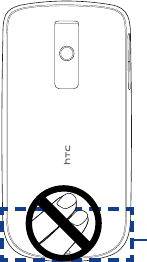
10
Antenna
location
General Precautions
• Avoid applying excessive pressure to the device
Do not apply excessive pressure on the screen and the device to prevent
damaging them and remove the device from your pants’ pocket before sitting
down. It is also recommended that you store the device in a protective case
and only use your finger when interacting with the touch screen. Cracked
display screens due to improper handling are not covered by the warranty.
• Device getting warm after prolonged use
When using your device for prolonged periods of time, such as when you’re
talking on the phone, charging the battery or browsing the web, the device
may become warm. In most cases, this condition is normal and therefore
should not be interpreted as a problem with the device.
11
• Heed service markings
Except as explained elsewhere in the Operating or Service documentation, do
not service any product yourself. Service needed on components inside the
device should be done by an authorized service technician or provider.
• Damage requiring service
Unplug the product from the electrical outlet and refer servicing to an
authorized service technician or provider under the following conditions:
•Liquid has been spilled or an object has fallen onto the product.
•The product has been exposed to rain or water.
•The product has been dropped or damaged.
•There are noticeable signs of overheating.
•The product does not operate normally when you follow the operating
instructions.
• Avoid hot areas
The product should be placed away from heat sources such as radiators, heat
registers, stoves, or other products (including amplifiers) that produce heat.
• Avoid wet areas
Never use the product in a wet location.
• Avoid using your device after a dramatic change in temperature
When you move your device between environments with very different
temperature and/or humidity ranges, condensation may form on or within
the device. To avoid damaging the device, allow sufficient time for the
moisture to evaporate before using the device.
NOTICE: When taking the device from low-temperature conditions into a warmer
environment or from high-temperature conditions into a cooler environment,
allow the device to acclimate to room temperature before turning on power.
12
• Avoid pushing objects into product
Never push objects of any kind into cabinet slots or other openings in the
product. Slots and openings are provided for ventilation. These openings
must not be blocked or covered.
• Mounting accessories
Do not use the product on an unstable table, cart, stand, tripod, or bracket.
Any mounting of the product should follow the manufacturer’s instructions,
and should use a mounting accessory recommended by the manufacturer.
• Avoid unstable mounting
Do not place the product with an unstable base.
• Use product with approved equipment
This product should be used only with personal computers and options
identied as suitable for use with your equipment.
• Adjust the volume
Turn down the volume before using headphones or other audio devices.
• Cleaning
Unplug the product from the wall outlet before cleaning. Do not use liquid
cleaners or aerosol cleaners. Use a damp cloth for cleaning, but NEVER use
water to clean the LCD screen.
13
Contents
Chapter 1 Phone Basics 21
1.1 Getting to Know Your HTC Magic and Accessories......................................... 22
Front panel ..................................................................................................................................22
Back panel ...................................................................................................................................23
Left panel.....................................................................................................................................23
Bottom panel..............................................................................................................................24
Inside the box.............................................................................................................................24
1.2 Installing the SIM Card, Battery, and Storage Card ....................................... 25
SIM card........................................................................................................................................26
Battery...........................................................................................................................................27
Storage card................................................................................................................................29
1.3 Charging the Battery........................................................................................ 30
1.4 Phone Controls ................................................................................................. 31
Search button.............................................................................................................................32
1.5 Getting Around Your Phone............................................................................. 32
Touch.............................................................................................................................................32
Touch and hold..........................................................................................................................32
Swipe or slide .............................................................................................................................33
Drag ...............................................................................................................................................33
Flick................................................................................................................................................33
Rotate............................................................................................................................................33
Use the Trackball.......................................................................................................................33
1.6 Getting Started ................................................................................................. 34
Turn your phone on and off..................................................................................................34
Enter your PIN ............................................................................................................................34
Set up your phone for the first time...................................................................................35
Retrieve your Google Account password.........................................................................36
Turn off the screen when not in use ..................................................................................36
14
1.7 Home Screen..................................................................................................... 37
Extended Home screen ..........................................................................................................38
Customizing the Home screen.............................................................................................39
1.8 Phone Status and Notifications....................................................................... 41
Status bar.....................................................................................................................................41
Notifications panel...................................................................................................................44
Notification LED ........................................................................................................................45
1.9 Applications...................................................................................................... 46
Recently-used applications...................................................................................................46
1.10 Settings ........................................................................................................... 47
1.11 Adjusting the Volume .................................................................................... 48
1.12 Using the Phone’s Storage Card as a USB Drive ........................................... 49
Chapter 2 Using Phone Features and Managing Contacts 51
2.1 Making Calls...................................................................................................... 52
Use the Dialer.............................................................................................................................52
2.2 Answering or Rejecting a Call.......................................................................... 54
Call Options.................................................................................................................................55
2.3 Using Call Log ................................................................................................... 58
2.4 Adjusting Phone Settings ................................................................................ 60
2.5 Turning the Phone Function On and Off......................................................... 60
2.6 Creating and Managing Contacts.................................................................... 61
Contact sources.........................................................................................................................61
Add a new contact ...................................................................................................................62
View your contacts...................................................................................................................64
Add favorite contacts ..............................................................................................................65
Edit and customize your contacts.......................................................................................66
Communicate with your contacts ......................................................................................67
2.7 Synchronizing Microsoft Office Outlook Contacts ........................................ 68
Install HTC Sync on your PC ..................................................................................................69
15
Set up HTC Sync ........................................................................................................................69
Synchronize contacts ..............................................................................................................70
Advanced options ....................................................................................................................71
Chapter 3 Entering Text 73
3.1 Using the Onscreen Keyboard......................................................................... 74
QWERTY .......................................................................................................................................74
Compact QWERTY....................................................................................................................75
Phone keypad ............................................................................................................................76
3.2 Entering Numbers and Symbols...................................................................... 77
3.3 Adjusting Text Input and Keyboard Settings ................................................. 78
Text input & keyboard settings............................................................................................78
Text input.....................................................................................................................................78
Chapter 4 Managing Your Time 81
4.1 Using Calendar..................................................................................................82
Open Calendar...........................................................................................................................82
Create events..............................................................................................................................82
Calendar views...........................................................................................................................83
Event reminders ........................................................................................................................84
Synchronize Exchange ActiveSync Calendar..................................................................85
4.2 Using Alarm Clock ............................................................................................ 86
Set an alarm ................................................................................................................................86
Customize Alarm Clock...........................................................................................................87
Delete an alarm .........................................................................................................................87
16
Chapter 5 Exchanging Messages 89
5.1 Sending Text and Multimedia Messages ........................................................ 90
Open Messaging .......................................................................................................................90
Create and send SMS and MMS messages......................................................................90
Receive text and multimedia messages...........................................................................95
Manage messages and message threads ........................................................................95
Adjust text and multimedia message settings ..............................................................98
5.2 Using Gmail/Google Mail ................................................................................ 99
Create and send emails ....................................................................................................... 100
Receive and read emails...................................................................................................... 102
Reply to or forward emails ................................................................................................. 103
Manage conversations and emails.................................................................................. 103
Set Gmail/Google Mail settings........................................................................................ 105
5.3 Using Mail........................................................................................................106
Add a POP3/IMAP email account..................................................................................... 106
Add a Microsoft Exchange ActiveSync account ......................................................... 108
Compose and send emails ................................................................................................. 108
Manage emails on your external email account ........................................................ 109
Edit or delete an email account........................................................................................ 110
Adjust email account settings........................................................................................... 110
5.4 Using Google Talk........................................................................................... 111
Sign in and chat online........................................................................................................ 111
Manage your friends............................................................................................................. 114
Mobile indicators ................................................................................................................... 116
Adjust instant messaging settings .................................................................................. 116
Sign out ..................................................................................................................................... 117
17
Chapter 6 Getting Connected 119
6.1 Connecting to the Internet ............................................................................120
GPRS/3G/EDGE ....................................................................................................................... 120
Wi-Fi ............................................................................................................................................ 121
6.2 Using Browser ................................................................................................. 123
View web pages ..................................................................................................................... 124
Manage links, history, and downloads........................................................................... 128
Manage bookmarks .............................................................................................................. 130
6.3 Using Bluetooth.............................................................................................. 131
Chapter 7 Getting Around with Maps 135
7.1 Using Maps...................................................................................................... 136
7.2 Searching for Places of Interest.....................................................................137
7.3 Viewing Maps.................................................................................................. 139
7.4 Getting Directions ..........................................................................................142
7.5 Finding your friends with Google Latitude ..................................................144
Open Latitude......................................................................................................................... 144
Share your locations ............................................................................................................. 144
Invite friends............................................................................................................................ 144
Accept an invitation.............................................................................................................. 145
Show your friends.................................................................................................................. 146
Connect with your friends.................................................................................................. 147
Control what you share ....................................................................................................... 147
18
Chapter 8 Camera, Multimedia, and Documents 149
8.1 Using Camera and Camcorder....................................................................... 150
Capture modes....................................................................................................................... 151
Take pictures............................................................................................................................ 151
Shoot videos............................................................................................................................ 152
Review screen ......................................................................................................................... 153
Camera menu panel ............................................................................................................ 154
8.2 Using Gallery................................................................................................... 155
Work with pictures ................................................................................................................ 156
Work with videos ................................................................................................................... 160
8.3 Using YouTube ................................................................................................162
Watch videos ........................................................................................................................... 163
Search for videos.................................................................................................................... 164
Share videos ............................................................................................................................ 164
8.4 Using Music..................................................................................................... 165
Music library ............................................................................................................................ 166
Play music................................................................................................................................. 167
Use playlists ............................................................................................................................. 168
Set a song as ring tone......................................................................................................... 170
Delete music on the storage card.................................................................................... 170
8.5 Viewing PDF Files............................................................................................171
8.6 Using Quickoffice............................................................................................172
Chapter 9 Using Android Market 175
9.1 Using Android Market ....................................................................................176
9.2 Getting Help....................................................................................................177
9.3 Finding Applications ...................................................................................... 177
9.4 Installing an Application................................................................................178
9.5 Managing Applications..................................................................................180
9.6 Uninstalling an Application........................................................................... 180
19
Chapter 10 Managing Your Phone 181
10.1 Changing Basic Settings ..............................................................................182
Set the date, time zone, and time.................................................................................... 182
Display settings ...................................................................................................................... 183
Ringer settings........................................................................................................................ 184
Phone services ........................................................................................................................ 185
Language settings................................................................................................................. 185
10.2 Protecting Your Phone .................................................................................186
Protect your SIM card with a PIN...................................................................................... 186
Protect your phone with a screen lock .......................................................................... 187
10.3 Managing Memory....................................................................................... 189
10.4 Synchronizing Google Apps........................................................................ 190
10.5 Resetting the Phone..................................................................................... 192
Appendix 193
A.1 Specifications .................................................................................................194
A.2 Regulatory Notices......................................................................................... 195
Index 203
20

Chapter 1
Phone Basics
1.1 Getting to Know Your HTC Magic and Accessories
1.2 Installing the SIM Card, Battery, and Storage Card
1.3 Charging the Battery
1.4 Phone Controls
1.5 Getting Around Your Phone
1.6 Getting Started
1.7 Home Screen
1.8 Phone Status and Notifications
1.9 Applications
1.10 Settings
1.11 Adjusting the Volume
1.12 Using the Phone’s Storage Card as a USB Drive
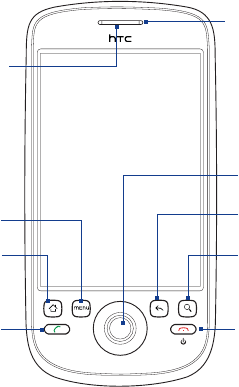
22 Phone Basics
1.1 Getting to Know Your HTC Magic and Accessories
Front panel
Notification LED
See “Phone Status and
Notifications” in this
chapter for details.
Touch Screen
HOME
END CALL/POWER
BACK
TRACKBALL
CALL
MENU
Earpiece
Listen to a phone
call from here.
SEARCH
For more information about the functions of the MENU, HOME, CALL, END CALL/
POWER, SEARCH, and BACK buttons, see “Phone Controls” in this chapter. For more
information about the TRACKBALL, see “Use the Trackball” in this chapter.
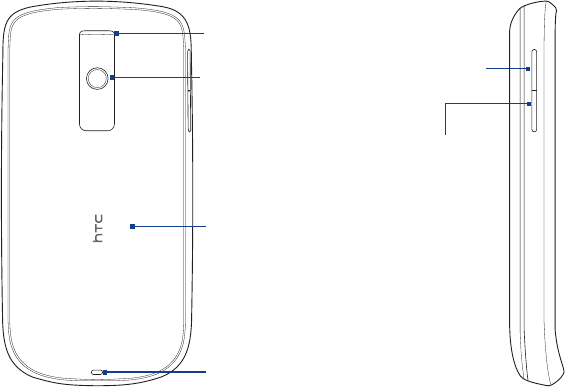
Phone Basics 23
Back panel Left panel
Back Cover
See “To remove the
back cover” in this
chapter.
3.2 Megapixel Camera
See “Using Camera” in
Chapter 8 for details.
Speaker
Strap Holder
VOLUME UP
Press to increase
the ringer or
media volume.
VOLUME DOWN
Press to lower the
ringer or media
volume.

24 Phone Basics
Bottom panel
USB Connector/Earphone Jack
Flip open the cover to connect the:
USB cable to transfer files.
AC adapter to recharge the battery.
USB stereo headset for hands-free conversation
or for listening to music and videos.
•
•
•
Microphone
Inside the box
The product package includes the following items and accessories:
Battery
USB cable
AC adapter
Wired stereo headset
•
•
•
•
Pouch
1GB microSD™ card
Screen protector
Quick Start Guide
•
•
•
•
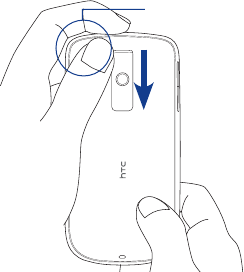
Phone Basics 25
1.2 Installing the SIM Card, Battery, and Storage Card
Always turn off your phone before installing or replacing the SIM card, battery, and
storage card. You also need to remove the back cover before you can install the SIM
card and battery.
To remove the back cover
Make sure the phone is turned off.
Firmly hold the phone with both hands and the front panel facing down.
Push the back cover down with your thumb until it disengages from the phone.
Push down from
this corner.
1.
2.
3.
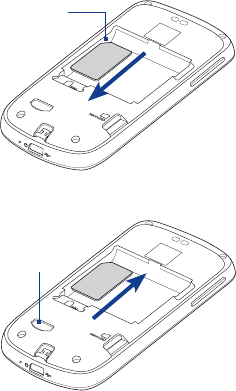
26 Phone Basics
SIM card
The SIM card contains your phone number, service details, and phonebook/
message memory. Your phone supports both 1.8V and 3V SIM cards.
Note Some legacy SIM cards may not function with your phone. You should consult your
wireless service provider for a replacement SIM card. There may be fees for this
service.
To install the SIM card
Make sure the phone is turned off.
Locate the SIM card slot, then insert
the SIM card with its gold contacts
facing down and its cut-off corner
facing out the card slot.
Slide the SIM card completely into the
slot.
1.
2.
3.
Cut-off
corner
To remove the SIM card
Remove the back cover and the
battery if it is installed.
Locate the groove below the SIM card
slot, then push the SIM card out of the
slot with your finger.
1.
2. Groove
Phone Basics 27
Battery
Your phone comes with a rechargeable Lithium-ion battery and is designed to use
only manufacturer-specified original batteries and accessories. Battery performance
depends on many factors, including network configuration, signal strength, the
temperature of the environment in which you operate your phone, the features
and/or settings you select and use, items attached to connecting ports, and your
voice, data, and other program usage patterns.
Battery life estimates (approximations):
Talk time:
Up to 400 minutes for WCDMA
Up to 450 minutes for GSM
Standby time: Up to 660 hours for WCDMA
Up to 420 hours for GSM
Note Battery life is subject to network and phone usage.
Warning! To reduce risk of fire or burns:
• Do not attempt to open, disassemble, or service the battery pack.
• Do not crush, puncture, short external contacts, or dispose of in fire or water.
•Do not expose to temperatures above 60oC (140oF).
•Replace only with the battery pack designated for this product.
• Recycle or dispose of used battery as stipulated by local regulations.
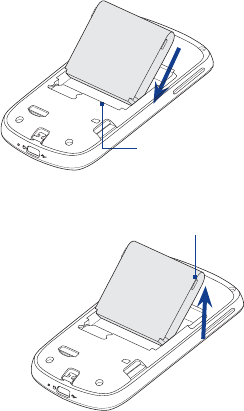
28 Phone Basics
To install the battery
Align the battery’s exposed
copper contacts with the battery
connectors inside the battery
compartment.
Insert the contact side of the
battery first then gently push the
battery into place.
Replace the back cover.
1.
2.
3. Battery contacts
To remove the battery
Make sure the phone is turned off.
Remove the back cover.
The top side of the battery has a
protruding grip. Lift the battery
from the grip to remove it.
1.
2.
3.
Battery grip
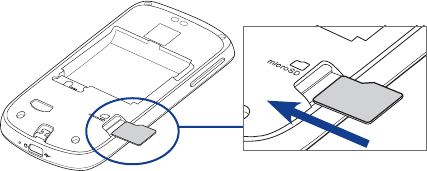
Phone Basics 29
Storage card
To store your pictures, music, and applications, install the supplied microSD™ card
into your phone.
Note You need to install the microSD card before you can use the Camera application.
To install the storage card
Insert the microSD card into the slot with its gold contacts facing down.
To remove the storage card
Press the storage card to eject it from the slot.
Note If you want to remove the storage card while the phone is on, see
“To remove the storage card while the phone is on” later in this chapter.
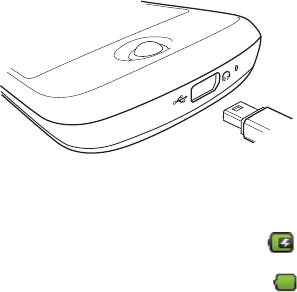
30 Phone Basics
1.3 Charging the Battery
New batteries are not charged when shipped. Before you start using your phone,
you need to install and charge the battery. Some batteries perform best after
several full charge/discharge cycles.
To charge the battery
Plug the USB connector of the AC adapter to the USB connector at the
bottom of your phone.
Plug in the AC adapter to an electrical outlet to start charging the battery.
Note Only the AC adapter and USB cable provided with your phone must be used to charge
the battery.
Charging is indicated by a solid amber light in the Notification LED. As the battery is
being charged while the phone is on, the charging battery icon ( ) is displayed
in the status bar of the Home screen. After the battery has been fully charged, the
Notification LED shows a solid green light and a full battery icon ( ) displays in
the status bar of the Home screen.
For more information about the Notification LED, see “Phone Status and
Notifications” in this chapter.
Warning! • Do not remove the battery from the phone while you are charging it using
the AC or car adapter.
• As a safety precaution, the battery stops charging when it overheats.
1.
2.
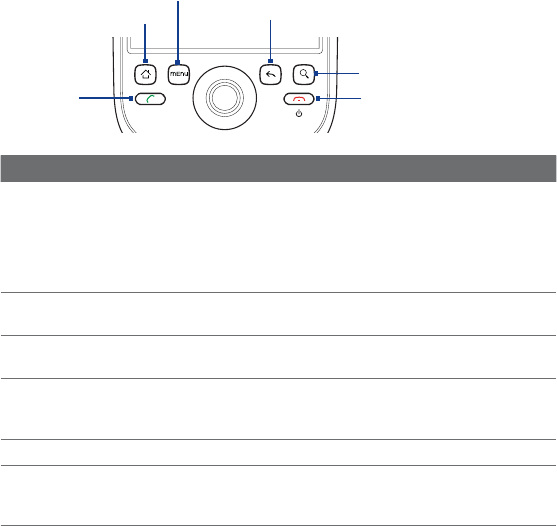
Phone Basics 31
1.4 Phone Controls
Press the control buttons on the front panel of your phone to do the following:
SEARCH
MENU
CALL
BACK
HOME
END CALL/POWER
Button Function
CALL Press to open the Phone screen.
When a contact, contact number, or phone number is highlighted on the
screen, press to call the contact or phone number.
While in a call, press to open the dialpad so you can add another call.
If you navigated to another application during a call, press to display the
ongoing call on the screen.
•
•
•
•
HOME While on any application or screen, press to return to the Home screen.
Press and hold to open the recently-used applications window.
•
•
MENU Press to open a list of actions that you can do on the current screen or options
menu.
BACK Press to go back to the previous screen, or to close a dialog box, options
menu, the Notifications panel, or onscreen keyboard.
Press and hold to return to the main screen of the current application.
•
•
SEARCH See “Search button” later in this chapter for details.
END CALL/
POWER
While in a call, press to hang up.
While not on a call, press and hold to open the phone options menu that
allows you to lock the screen, turn off, or put your phone in silent mode.
•
•

32 Phone Basics
Search button
Press SEARCH to search information on the current screen or application. For
example, while in the Contacts tab, press SEARCH to search contact-related
information such as names, phone numbers, or e-mail addresses in your contacts list.
Press SEARCH while in Maps to search for places of interest. Press SEARCH while in
the Home screen or Browser to launch Google™ search and search information on the
web.
In any search bar, enter the information you want to search, then press SEARCH
again, or touch on the screen.
1.5 Getting Around Your Phone
There are different ways to navigate around the Home screen, menus and
application screens on your phone.
Touch
When you want to type using the onscreen keyboard, select items onscreen such as
application and settings icons, or press onscreen buttons, simply touch them with
your finger.
Touch and hold
To open the available options for an item (e.g. contact or link in a web page), simply
touch and hold the item.
Phone Basics 33
Swipe or slide
To swipe or slide means to quickly drag your finger vertically or horizontally across
the screen.
Drag
Touch and hold your finger with some pressure before you start to drag. While
dragging, do not release your finger until you have reached the target position.
Flick
Flicking the screen is similar to swiping, except that you need to swipe your finger
in light, quicker strokes. This finger gesture is always in a vertical direction, such as
when flicking the contacts or message list.
Rotate
For most screens, you can automatically change the screen orientation from
portrait to landscape by turning the phone sideways. When entering text, you can
turn the phone sideways to bring up a bigger keyboard. Refer to Chapter 3 for more
details.
Note The Orientation check box in HOME > MENU > Settings > Sound & display needs
to be selected for the screen orientation to automatically change.
Use the Trackball
Roll or press the TRACKBALL to select or highlight items on the screen. The
TRACKBALL also flashes when you receive an incoming call or a notification.
34 Phone Basics
1.6 Getting Started
Once you’ve installed your SIM card, battery, and microSD card, you can turn on
your phone and start using it.
Turn your phone on and off
To turn on the phone
Press the END CALL/POWER button.
Note When you turn on the phone for the first time, you will be prompted to sign in to your
Google™ Account. For more information on how to set up your phone for the first
time, see “Set up your phone for the first time” in this chapter.
Enter your PIN
If your SIM card is preset with a PIN (personal identification number), you will be
prompted to enter the PIN to proceed. Enter the SIM PIN, then touch OK.
To learn how to enable or disable the SIM PIN, see “Protecting Your Phone” in
Chapter 10.
Note If you entered the wrong PIN three times, the SIM card will be blocked. If this happens,
you can unblock it with the PUK (PIN Unblocking Key) obtained from your wireless
service provider. Refer to Chapter 10 to learn how to unblock the SIM card.
To turn off the phone
Press and hold the END CALL/POWER button for a few seconds.
When the Phone options options menu appears, touch Power off.
Touch OK when prompted to turn off the phone.
1.
2.
3.
Phone Basics 35
Set up your phone for the first time
When you turn on the phone for the first time and after touching the Android
image, you will be prompted to sign in to your Google Account. If you decide not to
sign in to your Google Account, you can still use the phone but you won’t be able
to use Google services such as Google Talk™, Gmail™/Google Mail™, and Android
Market™.
Important You need to know your Google password to sign in. If you have forgotten your
password, refer to “Retrieve your Google password” later in this chapter to learn
how to retrieve your password.
Note Make sure that your phone has an active data connection (3G/GPRS) before you sign in
to your Google Account. See “Phone Status and Notifications” in this chapter to know if
your phone has an active data connection.
If you do not have an active data connection, press MENU and then touch APN settings
anytime when going through the initial setup to add APN settings. See “To create a new
access point” in Chapter 5 to learn how to set up a data connection
1. Touch Skip.
Tip Touch Begin to view a tutorial on how to use the onscreen keyboard.
2. Read the setup information on the screen, then touch Next.
3. Touch Sign in. Enter your user name and password, then touch Sign in. After
signing in, all emails, contacts, and calendar events on your Google Account
will automatically synchronize with your phone.
Tips • Touch Create if you do not have a Google Account yet. You need a Google Account
to use Google services.
•Touch Skip if you prefer to set up an account at a later time and start using your
phone.
4. Set up the date and time and then touch Next.
5. Touch Finish setup.
Note You can still change the operating system language later. To learn how to change the
operating system language, see “Language settings” in Chapter 10.
36 Phone Basics
Retrieve your Google Account password
If you forgot your Google Account password, you can retrieve it by doing the
following:
1. On your computer, open your browser and go to http://google.com.
2. On the upper-right side of the web page, click Sign in.
3. On the right side of the page, click I cannot access my account.
4. In the Please select your issue section, select I forgot my password.
5. Click Reset your password now, and then follow the procedure on how to
recover your password.
Turn off the screen when not in use
To save battery power, the phone automatically turns off the screen when you leave
it idle after a certain period of time. You will still be able to receive messages and
calls while the phone’s screen is off.
Tip For information on how to adjust the time before the screen turns off, see “Display
settings” in Chapter 10.
You can also turn off the screen by pressing the END CALL/POWER button. Pressing
any of the control buttons again or incoming calls will turn on your phone screen.
Note If you have set up a screen unlock pattern, you will be prompted to draw the pattern
on the screen before it unlocks. For more information on how to create and enable
the screen unlock pattern, see “Protecting Your Phone” in Chapter 10.
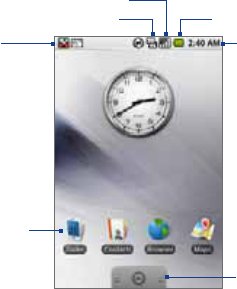
Phone Basics 37
1.7 Home Screen
The Home screen is your starting point for using the applications on your phone.
You can customize the Home screen to display application icons, shortcuts, folders,
and widgets according to your preference.
Notifications.
See “Phone Status
and Notifications”
in this chapter for
details.
Touch and hold
this area to display
the date.
•
•
Signal strength
Battery statusConnection status
Touch an icon to
open the related
application
Applications tab.
Touch to open and
select an application.
(See “Applications” in
this chapter for details.)
Time
Tip While in any application, press HOME to go back to the Home screen.
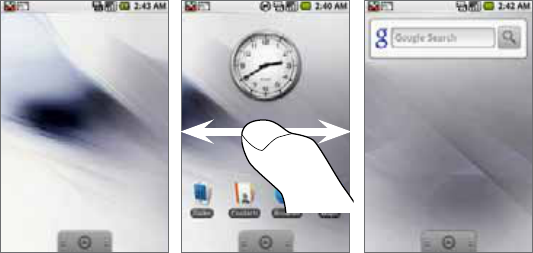
38 Phone Basics
Extended Home screen
The Home screen extends beyond the screen width to provide more space for
adding icons, widgets, and more. Press HOME, then slide your finger horizontally
across the screen to go to the left or right side of the extended Home screen.
Extended Home screen: Left Extended Home screen: Right
Tip While on an extended Home screen, you can also press HOME to return to the main
Home screen.
Phone Basics 39
Customizing the Home screen
To add a Home screen item
Press HOME, then touch and hold an empty area on the screen.
When the Add to Home options menu opens, select the item you want to
add to the Home screen:
•Shortcuts. Add shortcuts such as applications, a bookmarked web page, a
favorite contact, a Gmail/Google Mail label, or a music playlist.
Tip To quickly add an application shortcut that is on the Applications tab to the
Home screen, touch and hold an application icon. When the phone vibrates,
release the icon on an empty area on the Home screen.
•Widgets. Add a clock, music player, a picture frame, the Google search
bar, or a calendar that shows upcoming appointments.
•Folders. Add a folder where you can organize Home screen items, a
shortcut to all your contacts, contacts with phone numbers, or starred
contacts. Add a shortcut to all your contacts, contacts with phone
numbers, or starred contacts. Contact details are automatically updated
when there are changes in the source.
For more information on how to create folders, see “To create a folder and
add items to it” in this chapter.
•Wallpapers. Change the Home screen wallpaper. For more information
about customizing the wallpaper, refer to “To change the Home screen
wallpaper” later in this chapter.
1.
2.

40 Phone Basics
To reposition a Home screen item
1. Touch and hold the item on the screen you want to reposition to activate
Move mode.
Note When Move mode is activated, the item magnifies and the phone vibrates.
2. Without lifting your finger, drag the icon to the desired position on the
screen, then release it.
Note To move an item from the Home screen to an extended Home screen, touch and hold
the item and then drag it to the left or right edge of the screen until the display shifts
to the extended Home screen. Position the item on the screen, then release it.
To remove a Home screen item
1. Touch and hold the item on the screen you want to remove to activate Move
mode.
Note When Move mode is activated, the item magnifies and the phone vibrates.
2. Drag the icon to the Applications tab (The Applications tab changes
into )
3. When the icon and Application tab turn red, release it.
To change the Home screen wallpaper
1. Press HOME > MENU, and then touch Wallpaper.
2. Touch Pictures or Wallpaper gallery.
Touch Pictures to use a picture that you have captured using the camera
or copied to your phone as a wallpaper. You can crop the picture before
setting it as a wallpaper. See “To crop a picture” in Chapter 8 to learn how
to crop the picture.
Touch Wallpaper gallery to use preset wallpapers that came with the
phone.
3. Touch Save or Set wallpaper .
•
•

Phone Basics 41
To create a folder and add items to it
You can create folders on the Home screen to hold application icons or shortcuts.
1. Press HOME > MENU, and then touch Add > Shortcut > Folder. A new folder
appears on the screen.
2. Touch and hold an application icon or a shortcut on the Home screen to
activate Move mode, then drag it on top of the folder.
To access the items inside a folder, touch the folder to open it and then touch the
icon of the application or shortcut you want to open.
Tip To delete a folder, follow the same procedure when you want to remove a Home
screen item. See “To remove a Home screen item” earlier in this chapter.
To rename a folder
1. Touch the folder to open it.
2. Touch and hold the folder’s title bar to open the Rename folder dialog box.
3. Enter the Folder name and then touch OK.
1.8 Phone Status and Notifications
Status bar
On top of the phone screen is the status bar. The left side of the status bar displays
notification icons while the right side of the status bar displays the phone status.
Tip When the status bar is full, touch to display hidden icons/notifications.
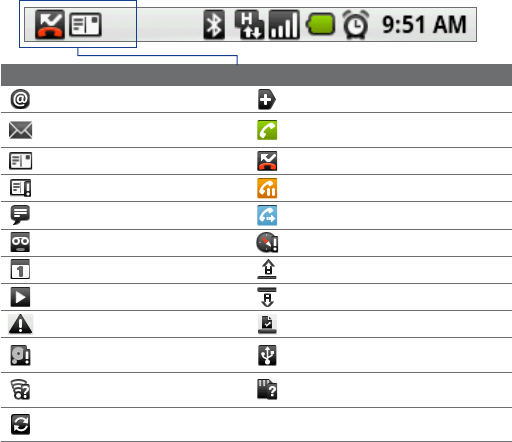
42 Phone Basics
Notification icons
These are the icons that may appear on the notifications area of the status bar:
Icons that appear in this area
New email message More (not displayed) notifications
New Microsoft Exchange
ActiveSync email message Call in progress
New SMS/MMS Missed call
Problem with SMS/MMS delivery Call on hold
New instant message Call forwarding on
New voicemail Compass needs orientation
Upcoming event Uploading data
Song is playing Downloading data
Problem with sign-in/sync Content downloaded
Storage card is full Phone connected to computer via
USB cable.
Wi-Fi is on and wireless
networks are available
No storage card installed on the
phone.
Synchronize Microsoft Office
Outlook data using HTC Sync
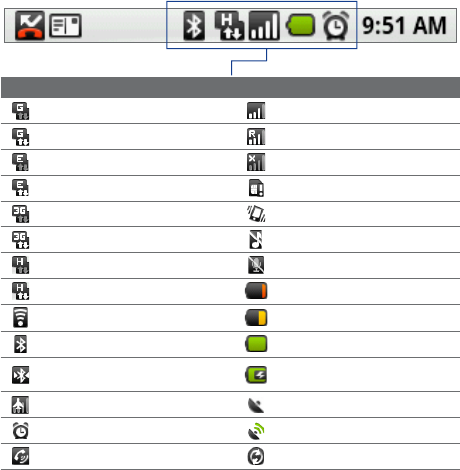
Phone Basics 43
Status icons
These are the icons that may appear on the status area of the status bar:
Icons that appear in this area
GPRS connected Signal strength
GPRS in use Roaming
EDGE connected No signal
EDGE in use No SIM card installed
3G connected Vibrate mode
3G in use Phone speaker is mute
HSPA connected Phone microphone is mute
HSPA in use Battery is very low
Connected to a Wi-Fi network Battery is low
Bluetooth is on Battery is full
Connected to a Bluetooth
device Battery is charging
Airplane mode GPS is on
Alarm is set GPS is connected
Speakerphone on Data is syncing
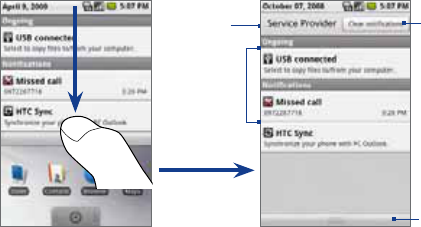
44 Phone Basics
Notifications panel
Notification icons report the arrival of new messages, calendar events, alarms set
and ongoing settings such as when call forwarding is on or the current call status.
You can open the Notifications panel to open the message, reminder, or event
notification and see the wireless service provider name.
To open the Notifications panel
When a new notification icon displays in the status bar, touch and hold the status
bar, then slide your finger downward to open the Notifications panel.
Operator
name
Touch a
notification
to open
the related
application. Touch and
hold, then
slide up to
close the
Notifications
panel.
Touch to
clear all
notifications.
If you have several notifications, you can scroll down the screen to view more
notifications.
Tip You can also open the Notifications panel on the Home screen by pressing MENU and
then touching Notifications.
To close the Notifications panel
Touch and hold the bottom bar of the Notifications panel, then slide your finger up
the screen or press BACK.
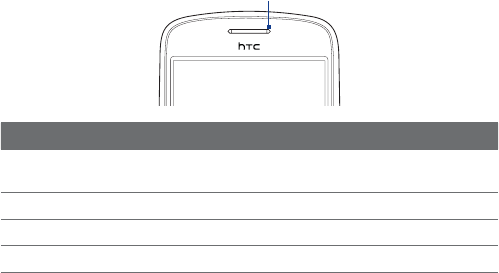
Phone Basics 45
Notification LED
The Notification LED located at the right corner of the earpiece provides
information on the phone status or pending notifications.
Notification LED
LED Status Indication
Solid green Battery is fully charged
(when the phone is connected to the AC adapter/computer).
Solid red Battery is charging.
Flashing red Battery is low.
Flashing green You have a pending notification.
Note The indicators are listed in order of priority. For example, if your phone is connected
to a power adapter and is charging the battery, the LED will be solid red and will not
switch to a flashing green light even if there is a pending notification.
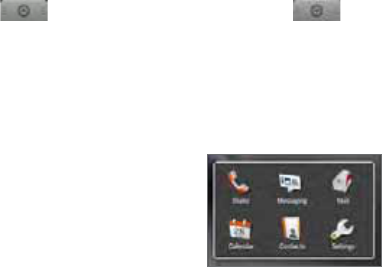
46 Phone Basics
1.9 Applications
The Applications tab holds all applications on your phone. All applications that
you downloaded and installed from Android Market or from the web are also added
to the Applications tab.
Important Some applications that are mentioned in the User Manual may not be available
on your phone by default. The applications available on the phone depends on
the region where you purchased the phone.
To open the Applications tab
Press HOME, then touch . To close the Applications tab, touch .
Tip To open applications quickly, you can add the icons of frequently-used applications to
the Home screen or to folders which you have created. For details, see “Customizing
the Home screen” earlier in this chapter.
Recently-used applications
To open a recently-used application
Press and hold the HOME button to open the
recently-used applications window.
The window displays the last six applications
you have used.
Touch an icon in the window to open the
related application.
1.
2.

Phone Basics 47
1.10 Settings
Control and customize phone settings on the Settings screen.
To open the Settings screen, do one of the following:
Press HOME > MENU, and then touch Settings.
Press HOME, then open the Applications tab, and then touch Settings.
Wireless controls Configure your phone’s wireless connections, such as Wi-Fi and
Bluetooth, enable the Airplane mode, or set the options for roaming,
networks, and more. See Chapter 6 for details.
Call settings Set up call services such as voice mail, call forwarding, call waiting, and
caller ID. See Chapter 2 for details.
Sound & display Set the call and notification ring tones, or set the screen brightness and
screen timeout. See Chapter 10 for details.
Data
synchronization
Select Google Apps™ and Microsoft® Exchange Activesync® items, if set
up, to synchronize. See Chapters 5 and 9 for details.
Location Select the GPS location source to use. See Chapter 7 for details.
Security Set the screen unlock pattern or enable the SIM card lock.
See Chapter 10 for details.
Applications Manage applications and installation of new programs.
SD card & phone
storage
Check the available storage card and phone memory or reset the phone
to its factory default settings. See Chapter 10 for details.
Date & time Set the date and time, time zone, and date or time format.
See Chapter 10 for details.
Locale & text Set the operating system language and region. You can also set onscreen
keyboard options.
About phone View the phone status such as the network type, signal strength, battery
power level, and network name. You can also view the legal information
and software version of your phone.
•
•

48 Phone Basics
1.11 Adjusting the Volume
Adjusting the Ringer volume changes the volume level of the phone ring
tone, whereas adjusting the Media volume changes the volume level of sound
notifications and music or video playback. The ringer volume and media volume
can be separately adjusted.
To adjust the Ringer volume
You can adjust the Ringer volume when you are on the Home screen or any
application screens (except during a call or when playing music/video).
Press the VOLUME UP or VOLUME DOWN buttons on the left panel of the
phone to adjust the ringer volume to your desired level. The Ringer volume
window appears on the screen to display the volume levels. While in the
lowest ringer volume level, press VOLUME DOWN once to set your phone to
Vibrate mode. The phone vibrates and the vibrate mode icon
( ) appears on the status bar.
While in Vibrate mode, press VOLUME DOWN once to turn off the sound of
your phone. The speaker mute icon ( ) displays on the status bar.
Tip To quickly switch your phone to silent mode, press and hold the END CALL/
POWER button, then touch Silent mode on the options menu.
You can also adjust the ringer volume on the Settings screen. To adjust, press
HOME > MENU, and then touch Settings > Sound & display > Ringer volume.
To adjust the media volume
When playing music or watching video, press the VOLUME UP or VOLUME DOWN
buttons on the left panel of the phone to adjust the media volume. The Music/
video volume window appears on the screen to display the volume level.
You can also adjust the media volume on the Settings screen.
Press HOME > MENU, and then touch Settings.
Touch Sound & display > Media volume.
1.
2.
1.
2.
Phone Basics 49
When the Media volume window appears, move the slider to the left (to
lower the volume) or to the right (to increase the volume).
Touch OK to close the window.
1.12 Using the Phone’s Storage Card as a USB Drive
To transfer music, pictures, and other files from your computer to your phone’s
storage card, you need to set the phone’s storage card as a USB drive.
To set the phone’s storage card as a USB drive
Connect the phone to the computer using the USB cable. A notification icon
appears in the status bar.
Open the Notifications panel. See “To open the Notifications panel” earlier in
this chapter to learn how to open the Notifications panel.
In the Notifications panel, touch USB connected and then touch Mount.
Note When you select Mount, the phone will not recognize the storage card when
it is connected to a computer. You will not be able to use some of the phone’s
applications such as Camera.
To remove the storage card while the phone is on
When you need to remove the storage card while the phone is on, you must
unmount the storage card first to prevent corrupting or damaging the storage card.
Press HOME > MENU, and then touch Settings.
Scroll down the screen, then touch SD card & phone storage.
Touch Unmount/eject SD card.
Remove the storage card by following the instructions in “To remove the
storage card” earlier in this chapter.
3.
4.
1.
2.
3.
1.
2.
3.
4.
50 Phone Basics

Chapter 2
Using Phone Features and
Managing Contacts
2.1 Making Calls
2.2 Answering or Rejecting a Call
2.3 Using Call Log
2.4 Adjusting Phone Settings
2.5 Turning the Phone Function On and Off
2.6 Creating and Managing Contacts
2.7 Synchronizing Microsoft Office Outlook Contacts
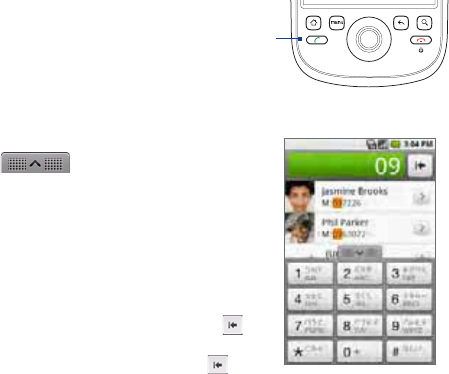
52 Using Phone Features and Managing Contacts
2.1 Making Calls
Use the phone’s Dialer application to make calls.
Use the Dialer
Do one of the following to open the Dialer:
Press HOME, then touch Dialer.
Press HOME, open the Applications
tab, then touch Dialer.
Press the CALL button.
•
•
•
CALL button
To make a call on a the Dialer
1. If the phone keypad is not open, open it by
touching at the bottom of the screen.
2. Begin entering the first few numbers or
characters of the contact by touching the keys
on the Phone keypad. As you enter numbers or
letters, the screen will display matches found
based on the phone keys you have touched.
The list is based on the contacts you have on your
phone and Call log.
If you touched a wrong number key, touch
to erase each subsequent digit of a number. To
erase the entire number, touch and hold .
Note After touching 6 keys and the number you are dialing is not in your contacts, an Add
to Contacts button will appear above the keypad. Tap it to save the number to your
Contacts.

Using Phone Features and Managing Contacts 53
3. Touch to close the phone keypad and to see if there are more
matching numbers or contacts. To browse through the filtered list, flick
through the list or slide your finger up or down the list slowly.
4. Touch the contact you want to call to place the call.
Note If the number you want to call does not appear on the screen, continue dialing
the number and then press CALL to place the call.
Tip During a call, press the VOLUME UP/DOWN buttons on the left panel of the phone to
adjust the in-call volume.
To make an emergency call
On the Phone screen, dial the international emergency number for your locale (for
example, 000), and press CALL.
Notes • When the screen is locked, you need to unlock it first before you can make an
emergency call. If your phone is in sleep mode, press any button to wake up the
phone and then press the MENU button to unlock the screen.
• Additional emergency numbers may be included in your SIM card. Contact your
wireless service provider for details.
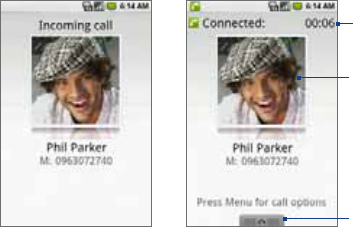
54 Using Phone Features and Managing Contacts
2.2 Answering or Rejecting a Call
When you receive a phone call from someone in Contacts, the Incoming call screen
appears and displays the caller ID icon, name, and phone number of the calling
party. When you receive a phone call from someone who is not stored in Contacts,
only the default caller ID icon and phone number will appear on the Incoming call
screen.
To answer an incoming call
Press the CALL button.
Incoming call screen Answered call screen
Call duration
Phone keypad.
Touch to open
and dial another
number.
Caller ID icon
To reject an incoming call
Press the END CALL/POWER button to reject and send the call to your voice mail.
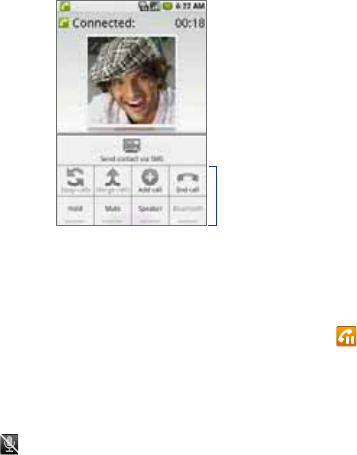
Using Phone Features and Managing Contacts 55
Call Options
When a call is in progress, press MENU to open the call options. Touch the available
buttons on the call options menu to put a call on hold, dial another contact for a
phone conference, mute the phone microphone, and more.
Call options
Note When the phone is dialing, only the End call and Speaker buttons are enabled.
Other buttons are disabled.
To put a call on hold
Press MENU, then touch Hold to put the call on hold. When you put a call on hold,
The Hold button indicator becomes green and the Hold call icon ( ) appears in
the status bar. Touch the Hold button again to resume the call.
To mute the microphone during a call
Press MENU, then touch Mute to toggle between turning the microphone on or off.
When the microphone is turned off, the Mute button indicator becomes green and
the Mute icon ( ) appears in the status bar.
Note If you are using the provided wired headset in a call, you can press the button on
the wired headset to mute the microphone. Press the button again to unmute the
microphone.

56 Using Phone Features and Managing Contacts
To turn the speakerphone on or off
During a call, press MENU, then touch Speaker to toggle between turning the
speakerphone on or off. The Speaker button indicator becomes green and the
speakerphone icon ( ) appears in the status bar when the speakerphone is on.
Warning! To avoid damage to your hearing, do not hold your phone against your ear when
the speakerphone is turned on.
To transfer the call to a Bluetooth headset
When a Bluetooth headset is paired and connected with your phone, you can
receive all incoming calls on the Bluetooth headset for hands-free conversation.
Tip Press MENU, then touch Bluetooth to toggle between using the phone speaker and
microphone or the paired Bluetooth device.
Note For more information on how to connect a Bluetooth headset or a Bluetooth car kit to
your phone, see “Using Bluetooth” in Chapter 6.
When the Bluetooth headset is disconnected from your phone, do the following to
reconnect it and transfer the ongoing call:
1. Make sure that Bluetooth on your phone and on the Bluetooth headset are
on. See “Using Bluetooth” in Chapter 6 for details.
2. During a call, press HOME > MENU, then touch Settings.
3. Touch Wireless controls > Bluetooth settings.
4. In the Bluetooth devices section, touch and hold the name of the Bluetooth
headset that you have previously paired with your phone, then touch
Connect on the pop-up window. When connected, the Bluetooth connected
icon ( ) appears in the status bar. The call is automatically transferred to
the Bluetooth headset.
5. Press TALK to display the ongoing call screen.
To transfer the call back to your phone, on the ongoing call screen, press MENU,
then touch Bluetooth.

Using Phone Features and Managing Contacts 57
To end a call
Do one of the following to end the call:
Press END CALL/POWER.
Press MENU, then touch End call.
If you are using the provided wired headset, press and hold the button to end
the call.
If the phone number of the person who called is not in your Contacts list, you can
choose to save the number after you hang up.
To add a new phone number after a call
You can choose to save the number of the caller if it is not in your Contact list after
you hang up.
Press CALL.
On the Phone screen, touch and hold the received call that you want to save
to your contacts list, then touch Add to contacts.
Tip You can also touch at the right side of the number to add it to your Contacts.
3. When the Contacts screen appears, touch Create new contact. The received
call number is automatically added to the Mobile phone field in the Dial
number section.
4. Enter other information for the contact, if desired.
5. Scroll down the screen, then touch Save.
•
•
•
1.
2.
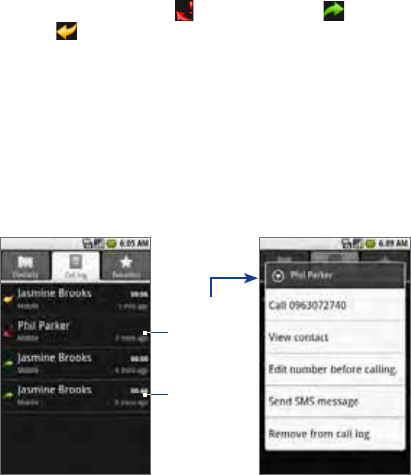
58 Using Phone Features and Managing Contacts
2.3 Using Call Log
The Call log tab lists all missed calls ( ), dialed numbers ( ),
and received calls ( ).
To use the Call log tab
Press CALL and then press MENU > Call log.
Do one of the following:
Touch the name or number in the list to call.
Touch and hold a name or number in the list to display the options menu
where you can select to call the contact, view the contact information (if
the number is stored in your contacts list), edit the number before you
redial, and more.
Touch to call
the contact.
Touch and
hold to open
the options
menu.
1.
2.
•
•

Using Phone Features and Managing Contacts 59
To add a new phone number to Contacts
If the phone number of a person who called is not in your contacts list, you can
choose to save the number after you hang up.
1. While on any screen, press the CALL button, then touch the Call log tab.
2. Touch and hold the received call that you want to save to your contacts list,
and then touch Add to contacts.
3. When the Contacts screen appears, touch Create new contact. The received
call number is automatically added to the Mobile phone field in the Phone
numbers section.
4. Enter other information for the contact, if desired.
5. Scroll down the screen, then touch Done.
Note For more information about creating contacts, refer to “Add a new contact” in this
chapter.
To check a missed call
You will see the missed call icon in the status bar when you missed a call.
To check who the caller was, press the CALL button, then touch the Call log tab.
Missed calls are indicated by the missed call icon ( ) on the left side.
Tip You can also touch and hold the status bar, then slide your finger downward on the
screen to open the Notifications panel. The missed call number and/or contact name
is displayed.
To clear the Call log
Do one of the following:
To remove a name or number from the Call log tab, touch and hold on the
name or number, then touch Remove from call log.
To clear the entire Call log, press MENU then touch Clear call log.
•
•
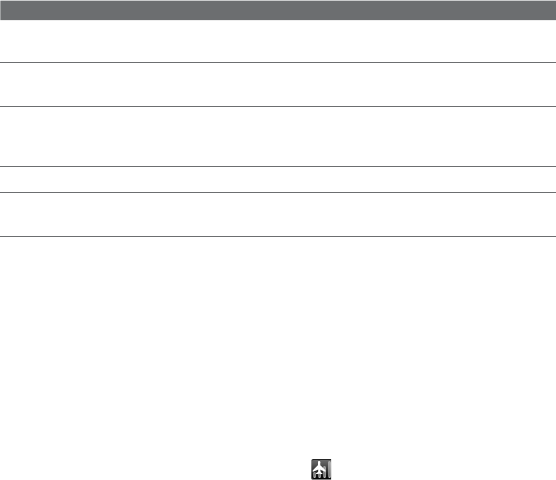
60 Using Phone Features and Managing Contacts
2.4 Adjusting Phone Settings
You can adjust the phone settings of your phone such as your voice mail number,
or enable additional call services from your wireless service provider.
To open the phone settings menu, press HOME > MENU, and then touch Settings >
Call settings.
Options Description
Fixed Dialing Numbers Restrict outgoing calls to a fixed set of numbers. To enable this
feature you must know your SIM card’s PIN2 code.
Voicemail Specify another voice mail number aside from the voice mail
number on your SIM card.
Call forwarding Select how you want your phone to handle busy, unanswered,
and unreachable calls. You can also set the call forwarding
option for all incoming calls.
Additional settings Enable or disable caller ID and call waiting services.
Network operators Scan and select a network operator manually, or set the network
selection to Automatic.
2.5 Turning the Phone Function On and Off
In many countries, you are required by law to turn off the phone while on board an
aircraft. A way to turn off the phone function is to switch your phone to Airplane
mode. When you enable Airplane mode, all wireless radios on your phone are
turned off, including the phone function, Bluetooth, and Wi-Fi.
To enable or disable Airplane mode
1. Press HOME > MENU, then touch Settings > Wireless controls.
2. Select the Airplane mode check box to enable or disable Airplane mode.
When enabled, the Airplane mode icon ( ) displays in the status bar.
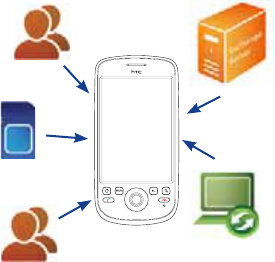
Using Phone Features and Managing Contacts 61
Tip When you disable Airplane Mode, the phone function is turned back on and the
previous state of Bluetooth and Wi-Fi is restored.
2.6 Creating and Managing Contacts
Similar to an online address book, the Contacts application gives you quick and
easy access to the people you want to reach. You can view and create contacts on
your phone and sync with your Gmail/Google Mail contacts on the web. You can
also import contacts stored on your SIM card, a Microsoft Exchange ActiveSync
account, and Microsoft® Office Outlook®.
To open Contacts
Press HOME and then touch Contacts.
Contact sources
You can add contacts to your phone from:
Gmail/Google Mail
contacts
Gmail/Google Mail
contacts are imported to
your phone after you set
up a Google Account.
Outlook contacts
See “Synchronizing
Microsoft Office
Outlook Contacts”
in this chapter for
details.
Phone contacts
See “To add a
new contact on
the phone” in this
chapter for details.
Exchange ActiveSync
Server
See “To import
contacts from the
Microsoft Exchange
ActiveSync Server” in
this chapter for details.
SIM card
See “To import contacts
from the SIM card” in
this chapter for details.
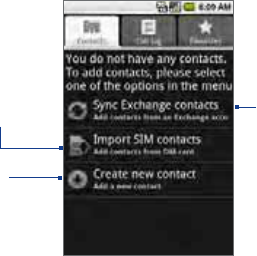
62 Using Phone Features and Managing Contacts
Add a new contact
When you open Contacts for the first time, you are presented with options on how
you can easily import your contacts into your phone.
Touch to import contacts
from your Exchange
ActiveSync account.
If you do not have an
Exchange ActiveSync
account, you will be taken
to the set up screen. For
more information about
setting up an Exchange
ActiveSync account, refer
to Chapter 5.
Touch to import
contacts stored on
your SIM card into the
phone. Refer to “To
import contacts from
the SIM card” in this
chapter for details.
Touch to create a
new contact on
the phone.
Note This screen will only appear if you do not have any contacts on the phone.
To add a new contact on the phone
1. In the Contacts tab, touch Create new contact.
Note If you have contacts already in the phone, press MENU and then touch
New contact.
2. Enter the contact’s name and other contact information such as their mobile
phone number, home phone number, or email address. Slide your finger up
or down to see more labels.
Note To change a default information label, for example Home email to Work email, touch
the information label button, then select another label on the menu. You can also
touch Custom on the menu to create another information label that is not in the list.
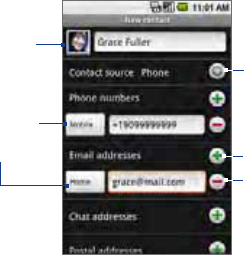
Using Phone Features and Managing Contacts 63
Touch to add a
caller ID icon.
Touch to delete
the information.
Touch to add
additional
information for
the section.
Touch to replace
or customize the
information label.
Touch to set what
type of contact.
Note If you want all calls from this contact to go directly to your voicemail, select the
Incoming calls check box.
3. When finished, press MENU and then touch Done.
To import contacts from the SIM card
You can add contacts saved on your SIM card to your phone’s contacts list.
1. In the Contacts tab, touch Import SIM contacts. Wait for the SIM card
contacts to load.
Note If you have contacts already in the phone, press MENU, and then touch Import
contacts.
2. Do one of the following:
To import a contact, touch the contact you want to import. This opens the
New contact screen where you can edit the contact details before saving.
To import all contacts, press MENU, and then touch Import all.
•
•
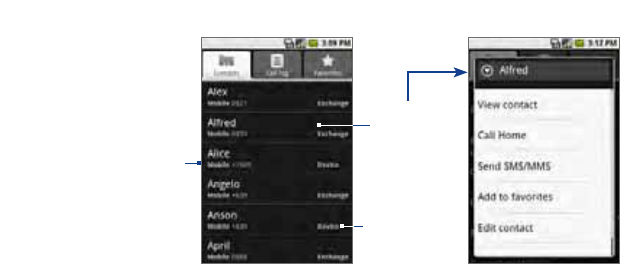
64 Using Phone Features and Managing Contacts
To import contacts from the Microsoft Exchange ActiveSync Server
If you have set up an Exchange ActiveSync account on your phone, you can add
contacts from that account to the phone’s Contacts list.
1. In the Contacts tab, touch Sync Exchange contacts.
Note If you already have contacts in the phone, press MENU, and then touch
Company directory.
2. Enter the name of the person you want to add and then touch Search.
3. In the search results, touch the name of the person you want to add to your
Contacts list.
4. In the contact’s details screen, press MENU and then touch Add to contacts.
To synchronize contacts from Microsoft Office Outlook
Refer to “Synchronizing Microsoft Outlook Contacts” in this chapter for details.
View your contacts
To view your contacts, press HOME, and then touch Contacts.
Touch to open
the contact
details screen.
Touch and
hold to open
the options
menu.
Indicates
the type of
contact.

Using Phone Features and Managing Contacts 65
Notes • When the contact is imported from your Gmail/Google Mail account, the word
Google will appear at the right side of the contact.
•If you imported a contact from a Microsoft Exchange ActiveSync account, the word
Exchange will appear at the right side of the contact.
• If you synchronized the phone with Microsoft Office Outlook contacts on your
computer, imported from the SIM card, or created a contact on the phone, the
word Phone will appear at the right side of the contact. See “Synchronizing
Microsoft Outlook Contacts” in this chapter for details.
Tip When you reply to or forward an email message to an email address that is not previously
stored in Contacts, the email address is automatically added to your contacts list.
Add favorite contacts
Use the Favorites tab as a way to filter your contacts list.
In the contacts list, touch and hold the contact to open the options menu.
Touch Add to favorites.
Tip You can also add a contact to the Favorites tab by touching the star on a contact’s
contact details screen.
Star
To remove a contact from the Favorites tab
On the Favorites tab, touch and hold the contact you want to remove and then
touch Remove from favorites on the options menu.
1.
2.

66 Using Phone Features and Managing Contacts
Edit and customize your contacts
To edit contact information
You can always make changes to the information you have stored for a contact.
In the contacts list, touch and hold the contact whose information you want
to edit, then touch Edit contact.
2. Edit the contact information, then touch Save. To ignore all changes you
made, touch Discard changes.
To change the contact’s default phone number
The default phone number of a contact appears below the contact’s name in the
contacts list. The default phone number is used when you initiate a call or send an
SMS/MMS message from the contacts list (by touching and holding a contact).
You can change the contact’s default phone number.
In the contacts list, touch the contact to open the contact details screen.
Touch and hold the phone number you want to use as the contact’s default
phone number, then touch Make default number. The default phone
number moves on top of the list and is marked with .
Press BACK to save your changes.
1.
1.
2.
3.
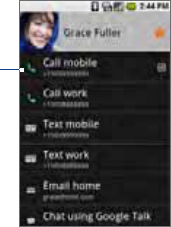
Using Phone Features and Managing Contacts 67
Communicate with your contacts
From the contacts list, you can quickly call
or send a text or multimedia message to a
contact’s default phone number.
However, to view all the information you have
stored for a contact, and to initiate other types
of communication with that contact, open the
contact details screen.
To open the contact’s details screen, touch the
contact name in the contacts list.
Default
phone
number.
To call a contact
Do one of the following:
In the contacts list, use the TRACKBALL to navigate to the contact you want
to call, then press the CALL button. The contact’s default phone number is
dialed.
To dial a different number for the contact, touch the contact’s name in the
contacts list to open the contact details screen, then touch a phone number
below the Dial number section.
To send a text or multimedia message to a contact
The contact must have a mobile phone number in their contact details for you to
send them a text or multimedia message.
Do one of the following:
When the contact’s default number is a mobile phone number, touch and
hold the contact’s name in the list, then touch Send SMS/MMS on the
options menu.
•
•
•
68 Using Phone Features and Managing Contacts
Touch the contact in the list to open the contact details screen, then touch
Text mobile,Text work, or another text option.
A compose screen opens for your message.
Note For more information about composing and sending text and multimedia messages,
see Chapter 5.
To send an email to a contact
The contact must have an email address in their contact details for you to send
them an email.
In the contacts list, touch the contact you want to send the email to.
When the contact details screen opens, touch Email home,Email work, or
another email option. A compose screen opens for your new email.
Note If you have more than one email account set up on your phone, you will be
prompted to select which account to use to send the message.
Note For more information about composing and sending email messages, see Chapter 5.
2.7 Synchronizing Microsoft Office Outlook Contacts
HTC Sync lets you synchronize Outlook, Windows Address Book (Outlook Express),
or Windows ontacts on your PC with your phone.
Requirement You need Outlook 2000/2002/2003/2007, Windows Address Book (Outlook
Express), or Windows Contacts and Windows XP Service Pack 2 (SP2) or higher
or Windows Vista to synchronize contacts.
Note If you have a Microsoft Exchange account, you can set up an Exchange email account
and synchronize emails, contacts, and calendar items from the Exchange account.
To set up a Microsoft Exchange email account, see “Add a Microsoft Exchange
ActiveSync account” in Chapter 5 for details.
•
1.
2.

Using Phone Features and Managing Contacts 69
Install HTC Sync on your PC
You can find the HTC Sync installer on the provided microSD card.
1. Make sure the microSD card is installed on the phone and then connect the
phone to the computer using the provided USB cable.
2. Set the phone as a USB drive. To learn how, see “To set the phone’s storage
card as a USB drive” in Chapter 1.
3. On the computer, copy HTCSync.exe from the storage card to the computer’s
desktop.
4. Double-click HTCSync.exe and then follow the installation instructions on the
screen.
Set up HTC Sync
1. On your computer, run HTC Sync.
2. Connect the phone to the computer using the provided USB cable.
Note On your phone, check Notifications on the status bar for the icon to know if
the phone recognizes HTC Sync.
3. The first time you synchronize the phone, the Synchronization Settings
Wizard starts automatically to help you set up HTC Sync.
4. On the Synchronisation Settings Wizard screen, click Next.
5. Select the PC application you want to synchronize with and then click Next.
6. Select the categories you want to synchronize and then click Next.
Note After clicking Next, you may be asked to select additional categories. This page
will only appear if any additional categories are supported by the connected
phone.
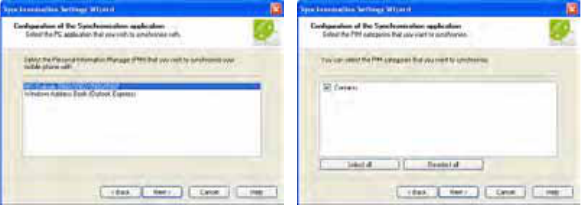
70 Using Phone Features and Managing Contacts
7. Select when to synchronize data and then click Next.
8. Check the settings that you have chosen and then click Finish.
Note By default, synchronization will start when you click Finish. If you do not want
synchronization to start right away, clear the Start synchronisation when I click
Finish check box.
If you want to have more customization features when setting up HTC Sync, you
can use Manual settings. To learn how to set up HTC Sync using Manual settings,
consult the HTC Sync help on your PC. To learn how to open the help, see “To open
HTC Sync help” later in this chapter.
Synchronize contacts
When you set up HTC Sync, you were asked to set when you want to synchronize
with the PC. Depending on the option you have selected, you may need to
manually start synchronization or it will automatically start synchronization when
you connect the phone to the PC.
Using Phone Features and Managing Contacts 71
To synchronize contacts
If you chose I want to synchronise automatically each time I connect my
mobile phone or Automatic start of synchronisation, every time mobile
phone is connected, follow this procedure:
On your PC, open HTC Sync.
Connect the phone to the PC using the USB cable.
Synchronization will automatically start.
If you chose I want to start the synchronisation manually or Do not sync
automatic, manual start, follow this procedure:
On your PC, open HTC Sync.
Connect the phone to the PC using the USB cable.
On the HTC Sync window, Click Synchronise Now.
If you chose Schedule automatic synchronisation, follow this procedure:
On your PC, open HTC Sync.
Connect the phone to the PC using the USB cable.
Synchronization will start depending on the date and time you set.
Advanced options
Open the HTC Sync Sync Manager comprehensive help file to learn more about the
advanced features of Sync Manager.
To open HTC Sync help
1. On your PC, open HTC Sync.
2. On the HTC Sync window, click Sync Manager.
3. On Sync Manager menu bar, click Help > Sync Manager Help.
•
1.
2.
3.
•
1.
2.
3.
•
1.
2.
3.
72 Using Phone Features and Managing Contacts

Chapter 3
Entering Text
3.1 Using the On-screen Keyboard
3.2 Entering Numbers and Symbols
3.3 Adjusting Text Input and Keyboard Settings
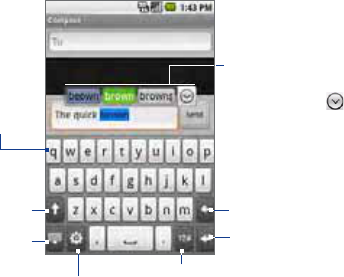
74 Entering Text
3.1 Using the Onscreen Keyboard
When you start a program or select a field that requires text or numbers, the
onscreen keyboard becomes available. You can choose from three keyboard
layouts: QWERTY,Compact QWERTY, and Phone keypad.
QWERTY
QWERTY is a keyboard layout similar to a desktop computer keyboard.
Displays the word
candidate list when
word prediction is
turned on. Touch a
word to insert it into
your text. Touch to
see more candidate
words.
• Touch to enter
letters or symbols.
• Touch and hold
to enter accented
letters.
• Touch to enter an
uppercase letter.
• Touch twice to turn
on Caps Lock.
Touch to switch to the numeric
and symbol keyboard. See
“Entering Numbers and Symbols”
for details.
Touch to create a
new line.
Touch to delete the
previous character.
Touch to toggle
between showing and
hiding the keyboard.
Touch to open a menu where you
can change the keyboard layout
and open the Touch Input Settings.
See “Adjusting Text Input and
Keyboard Settings” for details.
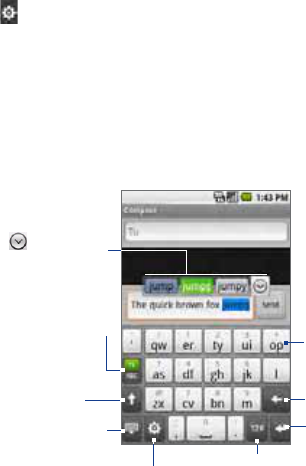
Entering Text 75
To enter text using QWERTY
1. Start a program that accepts text input
2. Touch , and then touch Keyboard types > QWERTY.
3. Start touching keys on the onscreen keyboard as you would on a PC keyboard
to enter your text.
Compact QWERTY
Compact QWERTY is a type of keyboard which features 20 keys. With its large,
touch-friendly keys and enhanced features such as T9 predictive input, you can
enter text faster and more accurately.
Touch to toggle
between using
Multitap or T9 mode.
Displays the word candidate
list in T9 mode. Touch a
word to insert it into your
text. Touch to see more
candidate words. • Touch to enter letters
or symbols.
• Touch and hold to
enter a punctuation
mark, symbol, or
number that appears
on top of a key.
• Touch to enter an
uppercase letter.
• Touch twice to turn
on Caps Lock.
Touch to switch to the numeric
and symbol keyboard. See
“Entering Numbers and Symbols”
for details.
Touch to create a
new line.
Touch to delete the
previous character.
Touch to toggle
between showing and
hiding the keyboard.
Touch to open a menu where you
can change the keyboard layout
and open the Touch Input Settings.
See “Adjusting Text Input and
Keyboard Settings” for details.
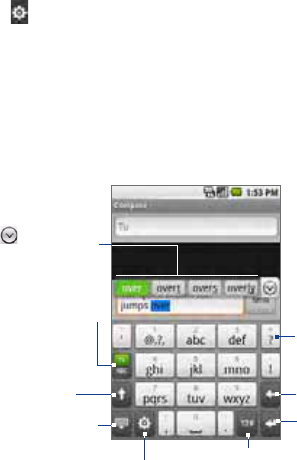
76 Entering Text
To enter text using Compact QWERTY
1. Start a program that accepts text input.
2. Touch , and then touch Keyboard types > Compact QWERTY.
3. Start touching keys on the onscreen keyboard to enter your text.
Phone keypad
Phone Keypad is a 12-key onscreen keypad that has a layout similar to mobile
phone keypads, plus some additional keys. The Phone Keypad has large keys and
enhanced input features such as T9 predictive input, which makes it faster for you
to enter text in your messages and documents.
Touch to toggle
between using
Multitap or T9 mode.
Displays the word candidate
list in T9 mode. Touch a
word to insert it into your
text. Touch to see more
candidate words. • Touch to enter letters
or symbols.
• Touch and hold to
enter a punctuation
mark, symbol, or
number that appears
on top of a key.
• Touch to enter an
uppercase letter.
• Touch twice to turn
on Caps Lock.
Touch to switch to the numeric
and symbol keyboard. See
“Entering Numbers and Symbols”
for details.
Touch to create a
new line.
Touch to delete the
previous character.
Touch to toggle
between showing and
hiding the keyboard.
Touch to open a menu where you
can change the keyboard layout
and open the Touch Input Settings.
See “Adjusting Text Input and
Keyboard Settings” for details.
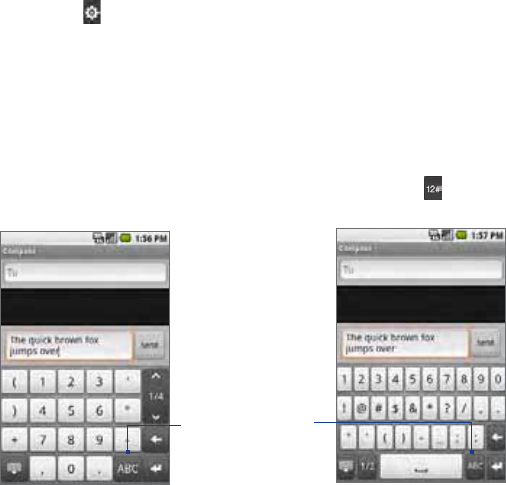
Entering Text 77
To enter text using Phone Keypad
1. Start a program that accepts text input.
2. Touch , and then touch Keyboard types > Phone Keypad.
3. Start touching keys on the onscreen keyboard to enter your text.
3.2 Entering Numbers and Symbols
Switch to the numeric and symbol onscreen keyboard to let you easily enter
numbers and common symbols such as parentheses, braces, currency signs,
punctuation marks, special characters, and more.
To switch to the numeric and symbol onscreen keyboard, touch on the
alphanumeric keyboard.
Touch to switch back
to the alphanumeric
keyboard.
Compact QWERTY and
Phone Keypad.
QWERTY

78 Entering Text
3.3 Adjusting Text Input and Keyboard Settings
Open the Text input & keyboard settings by doing one of the following:
On any of the keyboard layouts, touch to open the Text input & keyboard
settings.
On the Home screen, press MENU and then touch Settings > Locale & text >
Touch input.
Text input & keyboard settings
Keyboard types Touch to select the keyboard layout to use. You can choose
from QWERTY, Phone Keypad, or Compact Keyboard.
Keyboard language Touch to select the language layout of the keyboard.
Text input Touch to set text input options when entering text, calibrate the
keyboard, and set a sound and/or vibration feedback whenever you touch a
key. See “Text input” for details.
Tutorial Touch to learn tips about using the onscreen keyboard.
Text input
QWERTY
Prediction Select to enable the word prediction feature when using
QWERTY.
Spell correction Select to correct typographical errors by selecting from
a list of possible words that reflect the characters of the keys you have
touched as well as characters of nearby keys.
Phone keypad & Compact QWERTY
Spell correction Select to correct typographical errors by selecting from
a list of possible words that reflect the characters of the keys you have
touched as well as characters of nearby keys.
•
•
•
•
•
•
•
•
•
•
Entering Text 79
Word completion When using the Compact QWERTY or Phone
keypad, lets you select from a list of possible combinations based on the
characters that appear on the keys that you touched.
Other settings
Sound feedback Select to make a clicking sound whenever you touch a
key on the keyboard or an item on the menu.
Vibrate when typing Select to enable vibration feedback whenever you
touch a key on the keyboard or an item on the menu.
Finger touch precision
Calibration tool Touch to re-calibrate the keyboard touch accuracy.
Re-calibrate the keyboard if you feel that the keyboard keys are not
responding accurately to your touches.
Reset calibration Touch to reset the calibration back to factory default.
•
•
•
•
•
80 Entering Text

Chapter 4
Managing Your Time
4.1 Using Calendar
4.2 Using Alarm Clock
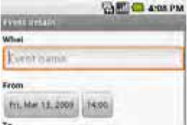
82 Managing Your Time
4.1 Using Calendar
Use Calendar to create and manage events, meetings, and appointments.
Depending on your synchronization settings, the Calendar on your phone stays in
sync with your Calendar on the web.
Note For more information about Calendar synchronization, see “Synchronizing Google
Apps” in Chapter 10.
Open Calendar
Press HOME, then touch the Applications tab to open it.
Touch Calendar.
Create events
To create an event
1. On any Calendar view, press MENU and then touch New event to open the
Event details screen.
2. Enter the event name using the keyboard.
3. Do one of the following:
If there is a time frame for the event, touch
the From and To date and time to set them.
If it is a special occasion such as a birthday
or a whole-day event, set the From and To
date, then select the All Day check box.
•
•
4. Enter the event location and description.
5. If you have more than one calendar, select the Calendar where you want to
save the event.
1.
2.
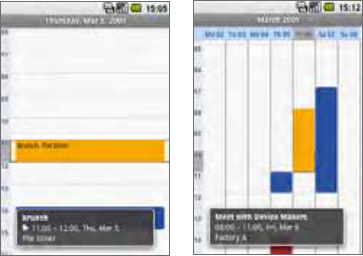
Managing Your Time 83
Note You can create multiple calendars, such as Personal, Business, or Family, using
Calendar on the web. Depending on your synchronization settings, these
calendars are added to your phone when you synchronize the Calendar. For
more information on how to create calendars, go to http://www.google.com/
support/calendar/bin/answer.py?answer=37095&topic=15281.
6. Set the event reminder time in Reminders, then select whether the event is
recurring in Repeats.
7. When finished, touch Save.
Tip To quickly create an event in Day, Week,or Month view, touch and hold an empty
time slot, then touch New event. A new Event details screen appears with the
selected time slot and date in the From fields.
Calendar views
You can display the Calendar in daily, weekly, monthly, or agenda view. To change
the Calendar view, press MENU, then touch Day,Week,Month, or Agenda.
Day view Week view
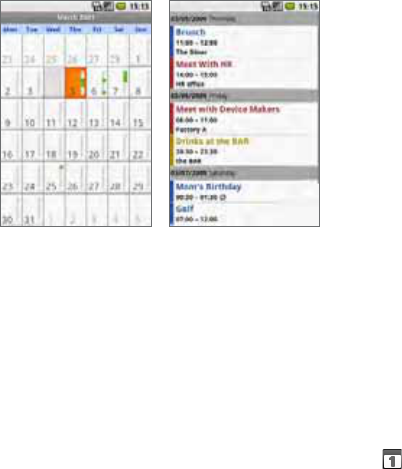
84 Managing Your Time
Month view Agenda view
While in a calendar view you can:
To quickly view the event’s details while in Day or Week view, highlight it
using the TRACKBALL. A quick view window appears on the lower part of the
screen.
Touch an event to edit or view details.
Touch and hold an event to open a window with options for viewing, editing,
or deleting that event, or creating a new event.
Event reminders
If you have set at least one reminder for an event, the upcoming event icon will
appear in the notifications area of the status bar to remind you of the upcoming
event.
To view, dismiss, or snooze the reminder
1. Touch the status bar, then slide your finger down the screen to open the
Notifications panel.
•
•
•
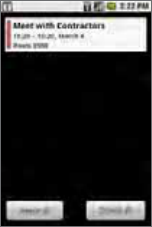
Managing Your Time 85
2. Touch the upcoming event name to display
the event.
Note If you have other pending event reminders,
these events will also appear on the screen.
3. Do one of the following:
Touch Snooze all to snooze all event
reminders for five minutes.
Touch Dismiss all to dismiss all event
reminders.
Press BACK to keep the reminders
pending in the notifications area of the
status bar.
•
•
•
Synchronize Exchange ActiveSync Calendar
If you have set up a Microsoft Exchange ActiveSync account on your phone, you can
also synchronize Exchange ActiveSync calendar events on your phone. Calendar
events on your Exchange ActiveSync will also show in Calendar if you chose to
synchronize with the Exchange ActiveSync Server.
To check if Exchange ActiveSync items are set to be synchronized, go to the Home
screen and press MENU and then touch Settings > Data synchronization >
Exchange ActiveSync.
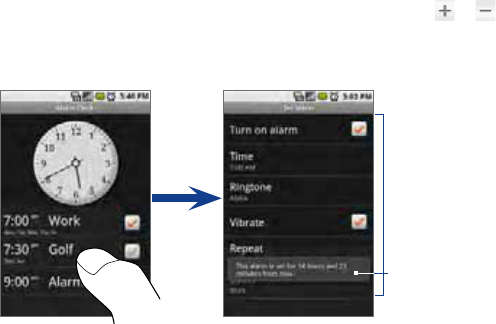
86 Managing Your Time
4.2 Using Alarm Clock
Use your phone as an alarm clock. Alarm Clock lets you set an unlimited number
of alarms.
To open Alarm Clock
Press HOME, then touch the Applications tab and then touch Alarm Clock.
When you open Alarm Clock for the first time, three alarms are set up by default,
ready for you to customize. All three alarms are turned off by default.
Set an alarm
Touch a default alarm.
2. Touch Time to set the alarm time. Adjust the time by touching or .
Touch AM to change to PM or vice versa, then touch Set when finished.
Note The number of hours and minutes left before the alarm goes off briefly displays
at the lower part of the screen after you set the alarm time.
Touch an option
to adjust the
alarm settings.
Time left before the
alarm goes off.
1.
Managing Your Time 87
3. Touch Ringtone, then select the alarm ring tone. The ring tone briefly plays
when selected.
Note Touch Vibrate if you want the phone to also vibrate when the alarm goes off.
4. Touch Repeat to select the days you want the alarm to sound, then touch OK.
Note By default, the alarm repeat is set to Never which means that your alarm will
only go off once.
5. Touch Label to set a name for the alarm.
6. Press BACK to return to the Alarm Clock screen.
Note If you need to set more than 3 alarms, you can add more alarms by pressing MENU
and then touching Add alarm while on the Alarm Clock screen.
You can temporarily disable an alarm by clearing the check box (by touching it) of
the alarm on the Alarm Clock screen.
Customize Alarm Clock
You can change the appearance of the clock displayed on the Alarm Clock screen.
On the Alarm Clock screen, touch the clock with your finger to open the clock
selection screen. Available clock displays appear at the bottom of the screen.
Slide your finger left or right on top of the clock displays to view them.
Touch the clock display you want.
Note To hide the clock display, on the Alarm Clock screen, press MENU, then touch
Hide clock.
Note To change the date and time format displayed in your alarms, see “Set the date, time
zone, and time” in Chapter 10.
Delete an alarm
On the Alarm Clock screen, touch the alarm you want to delete.
On the Set alarm screen, press MENU and then touch Delete alarm.
1.
2.
3.
1.
2.
88 Managing Your Time

Chapter 5
Exchanging Messages
5.1 Sending Text and Multimedia Messages
5.2 Using Gmail
5.3 Using Mail
5.4 Using Google Talk
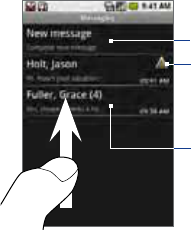
90 Exchanging Messages
5.1 Sending Text and Multimedia Messages
Messaging lets you compose and send text (SMS) and multimedia messages (MMS)
to other mobile phones.
Open Messaging
Press HOME, then touch the Applications tab, and then touch Messaging.
The message list appears.
Touch to create a new text
or picture message.
Touch to open the
message or message
thread and read the
text or view the picture
message.
If the list of messages
does not fit on the
screen, you can scroll
up the screen to view
more messages, or roll
the TRACKBALL down.
Message delivery status.
Create and send SMS and MMS messages
You can compose text (SMS) messages of up to 160 characters. If you continue to
type after the limit is reached, your message will be delivered as one, but count as
more than one message. These are called concatenated messages.
Multimedia messages, also known as MMS, can contain text and a picture, a
recorded voice, an audio file, or a picture slideshow.
Note Messaging automatically converts a text message into a multimedia message when you
entered an email address in the To field, added a message subject, or attached an item.
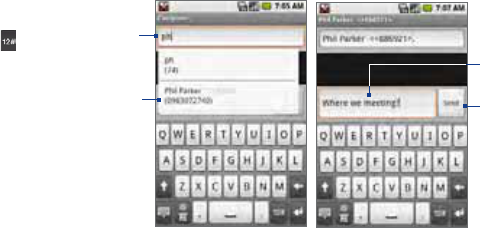
Exchanging Messages 91
To create and send a text message
1. On the Messaging screen, touch New message. The Compose screen opens.
2. Enter the mobile phone number of the message recipient in the To field. As
you enter the phone number, matching contacts will appear on the screen.
Touch a recipient or continue entering the recipient’s phone number.
Enter a name to look
up a contact or touch
to enter a phone
number. Enter your text
message here.
Touch to automatically
enter the mobile phone
number of the matched
contact.
Note: The phone
number only appears
if the number was
filed under Mobile in
Contacts.
Touch to send
the message.
3. Touch the text box that contains the text “Type to compose”, and then start
composing your message.
Note As you near the 160-character limit, a counter will appear in the top right corner
of the text box to tell you how many characters are left. Once you go over that
limit, a new message is created but automatically joined into one when received.
4. When done, touch Send to send the text message. The send progress is
displayed at the right side of the message in the message thread or in the
message list.
Note To receive delivery reports and know when a text message is received, in the message
list, press MENU and then touch Settings. In the SMS settings section, select the
Delivery reports check box.
92 Exchanging Messages
To create and send a multimedia (MMS) message
1. On the Messaging screen, touch New message. The Compose screen opens.
2. Enter the mobile phone number or email address of your message recipients
in the To field. As you enter the phone number or email address, matching
contacts will appear on the screen. Touch a recipient or continue entering the
recipient’s phone number or email address.
Tip You can add a subject line by pressing MENU and then touching Add subject.
3. Touch the text box that contains the text “Type to compose”, and then start
composing your message.
Note As you near the 160-character limit, a counter will appear in the top right corner
of the text box to tell you how much characters are left.
4. Press MENU and then touch Attach.
5. On the Attach window, select from the following file attachments:
Pictures. Opens the Gallery application. Touch a picture on the screen to
attach it to your message.
Capture picture. Opens the Camera application. Take a picture of your
subject, and then touch Attach to attach it to your message. For more
information about the Camera application, refer to “Using Camera” in Chapter
8.
Videos. Opens the Video application. Touch a video on the screen to attach it
to your message.
Record video. Opens the Video application. Take a video, and then touch
Attach to attach it to your message. For more information about the Video
application, refer to “Shoot videos” in Chapter 8.
Audio. Opens the Select audio menu. Touch an audio file to select, and then
touch OK to attach the file into your message.
•
•
•
•
•
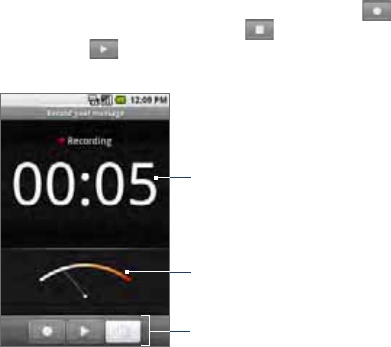
Exchanging Messages 93
Record audio. Touch to open the message recorder. Touch to start
recording your message, and then touch to stop. To listen to your
recording, touch . Touch Use this recording to attach the recording
into your message.
Volume meter
Recording and
playback controls
Recording duration
Slideshow. Touch to open the Edit slideshow screen. Touch Add slide to
create a new slide. Touch the created slide (for example, Slide 1), touch
Add picture, and then select the picture you want to add to the slide. You
can also navigate to the text box and enter a caption for the picture. Press
MENU to preview the slide, remove the picture, add a music, add another
slide, or change the slide duration or layout. When finished, touch Done
to attach the slideshow to your message.
•
•
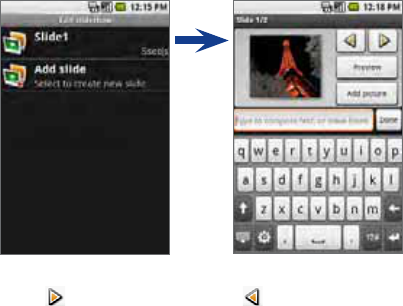
94 Exchanging Messages
Tip You can create a slideshow of up to ten slides. When editing multiple slides,
touch to edit the next slide or touch to return to the previous slide.
Notes • To view the slideshow, touch the Preview button while editing the slideshow, or
touch the Play button on the Compose screen.
•To remove or replace a picture or an audio attachment, on the Compose screen,
touch the Remove button beside the attachment. To remove a slideshow
attachment, on the Compose screen, touch Edit, press MENU, and then touch
Discard slideshow.
6. When you are finished composing the multimedia message, touch Send. The
send progress is displayed at the right side of the message in the message
thread or in the message list.
Note To receive delivery reports and know when a picture message is received, in the
message list, press MENU, and then touch Settings. Select the Delivery reports
check box below the MMS settings section.

Exchanging Messages 95
To save a message as a draft
While composing a text or multimedia message, press BACK to automatically save
your message as a draft. To resume composing the message, touch the message in
the message list. Continue editing the message, and then touch Send to send it.
Receive text and multimedia messages
Depending on your notification settings, the phone will play a ring tone, vibrate,
or display the message briefly in the status bar when you receive a new text or
multimedia message. To change the notification for new text and multimedia
messages, see “Adjust text and multimedia message settings” later in this chapter.
A new message icon ( ) also appears in the notifications area of the status bar
to notify you of a new text or multimedia message. To open the message, refer to
the next section.
Manage messages and message threads
Text and multimedia messages that are sent to and received from a contact (or
a number) are grouped into conversations or message threads. Threaded text or
multimedia messages let you see exchanged messages (similar to a chat program)
with a contact on the screen. Message threads are listed in order of when you
received them, with the latest message on top of the thread.
To open and read a text message
Do one of the following:
Press HOME, then touch and hold the status bar, and then slide it down to
open the Notifications panel. Touch the new message to open and read it.
•
96 Exchanging Messages
On the message list, touch the text message or message thread to open and
read it.
To return to the message list from a text message thread, press MENU and then
touch All threads.
Notes • To view the details of a particular message, in the message thread, touch and hold
the message to open the options menu, and then touch View message details.
•If a message contains a link to a web page, touch the link to open Browser and
view the web page.
•If a message contains a phone number, touch the message to open Dialer so you
can call the number.
To open and view a multimedia message
1. In the message list, touch a multimedia message or message thread to open
it.
2. Touch the Play button at the right side of a multimedia message to view it.
Tip You can save the file attachment on the multimedia message to the SD card.
To save, touch and hold the file and then touch Copy attached to SD card on
the options menu.
Notes • When Auto-retrieve in MMS settings is disabled, only the message header is
downloaded. To download the entire message, touch the Download button at
the right side of the message. Once the message has downloaded, touch the Play
button to view the message. For details, see “Adjust text and multimedia message
settings” later in this chapter.
•If you are concerned about the size of your data downloads, check the multimedia
message size before you download it.
To reply to a text or multimedia message
1. In the message list, touch a text or multimedia message thread to open it.
2. Use the TRACKBALL to navigate to the text box at bottom of the screen, enter
your reply message, and then touch Send.
•
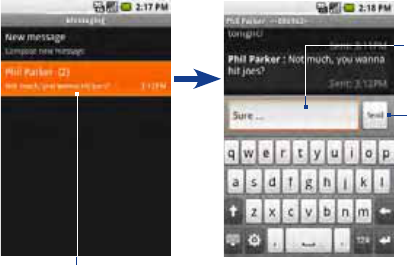
Exchanging Messages 97
Enter your reply
message here.
Touch to open the message.
Touch to send
your reply.
Tip To reply a text message with a multimedia message, open the text message,
press MENU and then touch Add subject, or Attach. The text message is
automatically converted into a multimedia message.
To delete a message or a message thread
1. In the message list, touch the message thread that you want to delete.
2. Do one of the following:
To delete the entire thread, press MENU and then touch Delete thread.
When prompted to confirm, touch OK.
To delete a message in a thread, touch and hold the message that you
want to delete, and then touch Delete message on the options menu.
When prompted to confirm, touch OK.
Note To delete all messages on the message list, press MENU on the message list and then
touch Delete threads.
•
•

98 Exchanging Messages
Adjust text and multimedia message settings
In the message list, press MEN and then touch Settings to adjust the text or
multimedia message settings. You can set the following options:
SMS settings
Delivery reports Select this option to receive a report on the delivery status of your
message.
Manage SIM card
messages
Touch to view text messages stored on your SIM card. You can also
delete or copy these messages to your phone’s memory.
MMS settings
Delivery reports Select this option to receive a report on the delivery status of your
message.
Read reports Select this option if you want to receive a report whether each
recipient has read or has deleted the message without reading it.
Auto-retrieve Select this option to automatically retrieve all your MMS messages
completely. When selected, the MMS message header plus the
message body and attachments will automatically download to your
phone. If you clear this check box, only the MMS message header will
be retrieved and shown in your message list.
Roaming
auto-retrieve
Clear this option if you only want the MMS message headers to
download while roaming. Select this option to automatically download
your complete multimedia messages even while roaming.
Notification settings
Notifications Select this option if you want to receive a notification in the status bar
when a new text or multimedia message arrives.
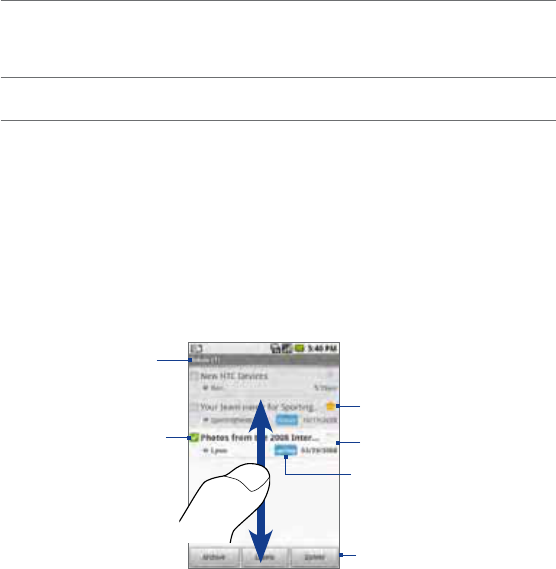
Exchanging Messages 99
Select ringtone If you want the phone to ring when a new message arrives, touch
this option, and then select a ring tone that is specific to new text
and multimedia messages. Note that the ring tone briefly plays when
selected.
Vibrate Select this option if you want the phone to vibrate when a new text or
multimedia message arrives.
5.2 Using Gmail/Google Mail
Gmail/Google Mail is Google’s web-based email service. Gmail/Google Mail is
configured when you first set up your phone. Depending on your synchronization
settings, Gmail/Google Mail on your phone is automatically synchronized with
your Gmail/Google Mail account on the web. For more information about
synchronization, see Chapter 10.
To open Gmail/Google Mail
Press HOME, then touch the Applications tab, and then touch Gmail/Google Mail.
To scroll through the
message list:
Slide your finger up/
down on the screen.
Roll the TRACKBALL
up/down.
•
•
Checked email.
Select one or more
emails to apply an
action.
Note: Batch
operations needs to
be enabled.
Message label.
Starred message.
Touch to add or
remove the star.
Folder (or Label) and
number of unread
email messages.
Actions for checked
email(s). This will not show
if there is no item selected
in the inbox.
Unread messages are
displayed in bold.
100 Exchanging Messages
The Inbox conversations list (hereinafter referred to as Inbox) is your default Gmail/
Google Mail view. All your received emails are delivered to your Inbox.
To refresh Gmail/Google Mail
Press MENU and then touch Refresh to send or receive new emails and to
synchronize your emails with your Gmail/Google Mail account on the web.
Create and send emails
To create and send an email
In the Inbox, press MENU and then touch Compose.
Enter the message recipient’s email address in the To field. If you are sending
the email to several recipients, separate the email addresses with a comma.
You can add as many message recipients as you want.
Note If you want to send a carbon copy (Cc) or a blind carbon copy (Bcc) of the email
to other recipients, press MENU and then touch Add Cc/Bcc.
3. Enter the email subject, and then compose your email.
Tip If you want to add a picture attachment, press MENU and then touch Attach.
Select the picture you want to attach, and then touch OK.
1.
2.
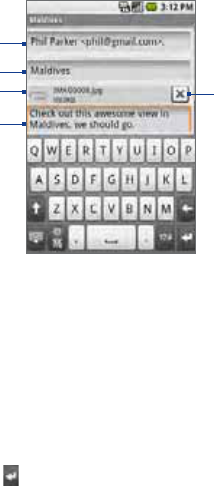
Exchanging Messages 101
Enter your
message here.
Touch to
remove the
attachment.
Recipient
Subject
Attachment
4. After composing your email, touch Send.
Note While composing the message, touch Save as draft or press the BACK button
to save it as a draft. To view your draft email messages, in the Inbox, press MENU
and then touch View labels > Drafts.
To add a signature to emails
You can add a signature to email messages that you send.
In the Inbox, press MENU and then touch Settings > Signature.
Enter your signature in the text box, and then touch OK.
Tip You can create a signature consisting of multiple lines of text. At the end of each
line of text, touch on the onscreen keyboard to create another line.
To view your sent messages
In the Inbox, press MENU and then touch View labels > Sent.
1.
2.
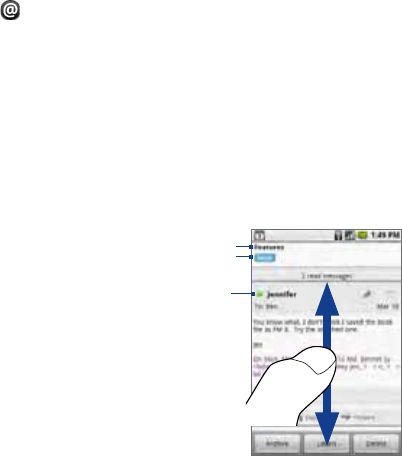
102 Exchanging Messages
Receive and read emails
Depending on your notification settings, the phone plays a ring tone, vibrates, or
displays the email message briefly in the status bar when you receive a new email.
A new email message ( ) icon also appears on the notifications area of the status
bar to notify you of a new email.
Note For more information on email notification settings, refer to the “Set new email
notifications” section later in this chapter.
Gmail/Google Mail groups each message you send with all the responses you
receive. This conversation list continues to grow as new replies arrive, so you can
always see your messages in context. Conversations are also referred to as message
threads. A new message or a change to the subject of a current message will begin
a new thread.
To view emails
Do one of the following:
Press HOME, then touch
and hold the status bar, and
then slide down your finger
on the screen to open the
Notifications panel. Touch the
new email to view it.
While in the Inbox, touch
the unread email or the
conversation with the unread
email to view it.
•
•To scroll through the
message:
Slide your finger
up/down on the
screen.
Roll the TRACKBALL
up/down.
•
•
Online status.
Appears when the
contact is a Google
Talk friend and you
are signed in to
Google Talk.
Message subject
Message label
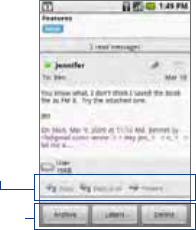
Exchanging Messages 103
To search for email messages
You can search for a specific email message by sender, word in a subject, or label.
In the Inbox, press MENU and then touch Search.
Enter the search keyword in the box, and then touch Search.
Reply to or forward emails
In the message thread, scroll down to
the end of the conversation.
2. Touch Reply, Reply to all, or
Forward.
3. Do one of the following:
If you selected Reply or Reply all,
enter your reply message.
If you selected Forward, specify
the message recipients.
4. Scroll down to the end of the
message, and then touch Send.
1.
•
•Message
options
Thread
options
Manage conversations and emails
Conversations
In the Inbox, touch and hold the conversation, and then touch:
Read to open the email.
Archive to archive the conversation.
Tip To display your archived messages, in the Inbox, press MENU and then touch
View labels > All Mail.
Mute to mute the entire conversation.
Tip If you’re part of a long message conversation that isn’t relevant, you can ‘mute’
the conversation to keep all future additions out of your Inbox.
1.
2.
•
•
•
104 Exchanging Messages
Mark read or Mark unread as desired. Unread messages are displayed in
bold in the Inbox.
Delete to delete the conversation.
Add star or Remove star to assign a star or remove the star on the
conversation .
Change labels to add or change the label of the conversation.
Note You cannot use the phone to create labels; do that on the Gmail/Google Mail
web site.
Report spam to report the conversation as spam.
Email messages
In the message thread, navigate to the email header or message using the
TRACKBALL, press MENU and then touch:
Archive to archive the email message.
Tip To display your archived messages, in the Inbox, press MENU, and then touch
View labels > All Mails.
Add star or Remove star to assign a star or remove the star on the
conversation .
Mark read or Mark unread as desired. Unread messages or threads with
unread messages display in bold in the Inbox.
Change labels to add or change the label of the conversation.
Note You cannot use the phone to create labels; do that on the Gmail/Google Mail
web site.
Delete to delete the email message.
More >
Back to Inbox to return to your Inbox.
Mute to mute the entire conversation.
•
•
•
•
•
•
•
•
•
•
•
•
•
Exchanging Messages 105
Tip If you’re part of a long message conversation that isn’t relevant, you can ‘mute’
the email to keep all future additions out of your Inbox.
Report spam to report the email message as spam.
Set Gmail/Google Mail settings
1. In the Inbox, press MENU and then touch Settings.
2. Set the following options:
Signature Touch to enter a signature that is appended at the end of your
emails.
Confirm delete Select the check box to show a confirmation box when
you delete a conversation.
Batch operations Select the check box to show the batch operations
feature. The Batch operations feature lets you archive, delete, or apply a
label to multiple emails at once.
Labels Touch to select which Gmail/Google Mail labels to synchronize.
Email notifications Select the check box to show a notification icon on
the status bar when you receive a new email.
Touch Select ringtone if you want your phone to ring when a new email
message arrives. On the ring tone menu, select a ring tone specific to new
email messages. The ring tone plays briefly when selected. If you don’t
want a ring tone to play when you receive a new email message, touch
Silent. Then touch OK to confirm your ringtone selection.
Select Vibrate if you want your phone to vibrate when you receive a new
email message.
•
•
•
•
•
•
•
•
106 Exchanging Messages
5.3 Using Mail
The Mail application comes with an email wizard that lets you add external POP3
or IMAP email accounts from popular web-based email service providers such
as Yahoo!® Mail Plus, AOL, and a Microsoft Exchange ActiveSync account on your
phone.
To open Mail
Press HOME, then touch the Applications tab, and then touch Mail.
Add a POP3/IMAP email account
1. Press HOME, then touch the Applications tab, and then touch Mail.
2. On the Choose a mail provider screen, touch Other (POP3/IMAP).
Note If the account type you want to set up is not in the phone database, you will
be asked to enter more details. It is recommended that you get all pertinent
information for the email account such as incoming/outgoing server settings
before you proceed.
3. Enter the Email address and Password for the email account and then touch
Next.
4. Enter the Account name and Your name and then touch Done.
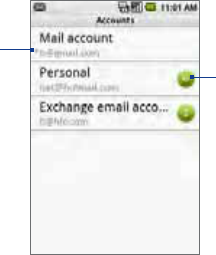
Exchanging Messages 107
Number of
unread emails.
Asterisk denotes
default email
account.
To create another email account
Do one of the following:
If you are in the Accounts list screen, press MENU, and then touch New
account
If you are in the Inbox of an email account, press MENU and then touch
More > New account.
Tip If you are in the Inbox of one of your email accounts and you want to go back to the
Accounts list screen, press MENU and then touch More > Accounts list.
•
•
108 Exchanging Messages
Add a Microsoft Exchange ActiveSync account
You can only add one Microsoft Exchange ActiveSync account on your phone.
Requirement You can sync with a Microsoft Exchange Server 2003 Service Pack 2 (SP2) or
Microsoft Exchange Server 2007.
1. Press HOME, then touch the Applications tab, and then touch Mail.
2. On the Choose a mail provider screen, touch Exchange ActiveSync.
3. Enter the Exchange ActiveSync account details and then touch Next.
Note Your corporate Exchange Server must support auto-detect for the phone
to automatically set up the Exchange ActiveSync account. If your corporate
Exchange Server does not support auto-detect, you will need to enter your
Exchange Server settings after you touch Next. Ask your Exchange Server
administrator for details.
4. Select the type of information you want to synchronize and then touch Done.
You can change the types of Exchange ActiveSync information you want to
synchronize after setting up the account. To change, press HOME > MENU, and then
touch Settings > Data synchronization > Exchange ActiveSync.
To change synchronization settings
You can change synchronization settings after setting up the Exchange ActiveSync
Server account.
1. Press HOME > MENU, and then touch Settings > Data synchronization >
Exchange ActiveSync.
2. Press MENU and then touch Settings.
3. Change the general settings and mail and calendar settings according to your
preference.
4. Press BACK after you are done.
Exchanging Messages 109
Compose and send emails
1. Press HOME, then touch the Applications tab, and then touch Mail.
2. On the email account Inbox, press MENU and then touch Compose.
Note If the current email account is not the account you want to use, press MENU and
then touch More > Accounts list to choose a different email account.
3. Enter the message recipient’s email address in the To field. As you enter
information, matching contacts will appear on the screen. Touch the
recipient or continue entering the email address. If you are sending the email
to several recipients, separate the email addresses with a comma. You can
add as many message recipients as you want.
Note If you want to send a carbon copy (Cc) or a blind carbon copy (Bcc) of the email
to other recipients, press MENU and then touch Add recipient.
Tip If you have set up an Exchange ActiveSync account, press MENU and then touch
Add recipient > To > Company tab to let you add recipients from the Exchange
ActiveSync account contacts.
4. Enter the subject, and then compose your message. Touch Send.
Note Touch Save as draft to save the message as a draft.
Manage emails on your external email account
To sort messages
1. On the email account Inbox, press MENU, and then touch Sort.
2. Select from the following sort options:
Date (Most recent/Oldest) Sorts email messages by the time you
received it.
Subject (A-Z/Z-A) Alphabetically sort email messages by subject.
Sender (A-Z/Z-A) Alphabetically sort email messages by sender.
Size (Largest/Smallest) Sort emails by file size.
3. Touch OK.
•
•
•
•
110 Exchanging Messages
To delete a message
1. On the email account Inbox, touch and hold the email you want to delete.
2. On the options menu, touch Delete. When prompted to confirm deletion,
touch OK.
Edit or delete an email account
You can edit or delete an external email account on your phone.
1. Press HOME, touch the Applications tab, and then select Mail. The Accounts
list screen appears.
Note If the Account list screen does not open, in the Inbox of the email account, press
MENU and then touch More > Accounts list.
2. Do one of the following:
To delete, touch and hold the account you want to remove, and then
touch Delete account on the options menu. When prompted to confirm
deletion, touch OK.
To edit, touch and hold the account you want to edit, and then touch
Settings on the options menu. See the next section for details.
Adjust email account settings
Press HOME, touch the Applications tab, and then touch Mail. The Accounts
list screen appears.
Note If the Account list screen does not open, in the Inbox of the email account, press
MENU and then touch More > Accounts list.
2. Touch and hold an email account on the screen, and then touch Settings.
3. Touch one of the following to edit or adjust:
•
•
1.

Exchanging Messages 111
Account info Change the email account settings such as the name, email
address, password, and description.
General settings Set the font size when reading emails and enable/disable the
signature. Touch Signature to change the signature text.
Send & receive Set the maximum email file size limit when receiving and
frequency to check for new emails and how many to check for.
You can also set to have emails that you send bcc’d to yourself.
Notification settings Set email notification settings.
4. Press BACK to save your changes.
5.4 Using Google Talk
Google Talk is Google’s instant messaging program. It lets you communicate with
other people that also use Google Talk.
Note The Google Talk account that is set up is based on the Gmail/Google Mail account that
you used when you set up the phone.
Sign in and chat online
To open Google Talk
Press HOME, then touch the Applications tab, and then touch Google Talk.
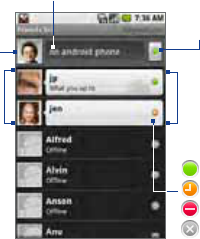
112 Exchanging Messages
Online status:
Available
Idle
Busy
Offline
Opened chats. Touch a
callout to open the chat
screen and start chatting
with your friend.
Friends list
Touch to
change your
picture
Touch to change your online status message.
Touch to change your
online status.
To add a new friend
You can only add people who have a Google Account.
In the Friends list, press MENU and then touch Add friend.
Enter the Google Talk instant messaging ID or Google email address of the
friend you want to add.
Note When you add a friend with an instant messaging ID and has been saved in your
contacts list, matching contacts will display on the screen as you enter information.
You can touch the contact or continue entering the IM information.
3. Touch Send invitation.
To view and accept an invitation
In the Friends list, press MENU and then touch Invites. All chat invitations you
have sent or received are listed on the pending invitations screen.
Touch a pending invitation, and then touch Accept or Decline.
Note When someone you invite to chat accepts your invitation, the pending invitation
disappears from the list.
1.
2.
1.
2.
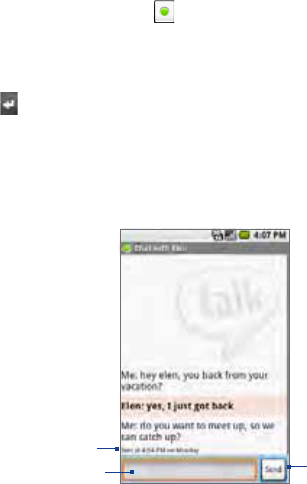
Exchanging Messages 113
To change your online status and message
1. Touch the online status icon ( ) beside your name, and then select the
status you want on the menu.
2. Touch the text box on the right of your online status icon and then enter your
status message using the onscreen keyboard.
3. Touch .
To start a chat
Do one of the following:
Touch a friend in the Friends list.
Navigate to a friend using the TRACKBALL, and then press the TRACKBALL.
Touch to send
your message.
Enter your message here.
Timestamp.
Appears after every
minute of inactivity.
2. Chat with your friend by entering text using the onscreen keyboard.
Note To insert a smiley, press MENU and then touch Insert smiley. Touch a smiley to
insert it into your message.
3. After entering your message, touch Send.
1.
•
•

114 Exchanging Messages
To switch between active chats
You can switch between chats if you have more
than one chat going.
1. While on a chat screen or in the friends list,
press MENU and then touch Switch chats.
2. On the panel that opens, touch the friend
you want to chat with.
Touch to switch chat
with this friend.
To close a chat
Do one of the following:
In your Friends list, touch and hold a friend with an active chat and then
touch End chat on the menu.
While on a chat screen, press MENU and then touch End chat.
Manage your friends
Friends in your friends list is sorted by their online status — active chats, online,
busy, and offline. Within the status groupings, friends are listed alphabetically.
By default, only the friends that you frequently communicate with — the most
popular — are in the Friends list. If you want to display all your friends, press MENU
and then touch All friends.
Tip To switch back to displaying only your most popular friends, press MENU and then
touch Most popular.
To find a friend
In the Friends list, start entering the name of your friend to filter your list to show
only friends with names that match what you have entered.
To block a friend
You can block a friend from sending you messages. When blocked, your friend is
also removed from your Friends list.
•
•
Exchanging Messages 115
1. In the Friends list, locate the friend you want to block.
Note If you cannot see the friend, Press MENU and then touch All friends.
2. Touch and hold the friend’s name, and then touch Block friend.
Your friend is removed from your friends list and is added to the blocked
friends list.
Note To unblock a friend, in the Friends list, press MENU and then touch Blocked. In the
Blocked friends list, touch the name of the friend you want to unblock, and then
touch OK when prompted.
To pin a friend
You can pin a friend to make sure that friend always appears in your Most popular
friends list.
In the Friends list, Touch and hold the friend’s name to open the options
menu.
Note If you cannot see the friend, Press MENU and then touch All friends.
2. Touch Pin friend.
Note To unpin a friend, in the Friends list, touch and hold the friend you want to unpin and
then touch Unpin friend on the options menu.
To show a friend in the Most popular list
In the Friends list, touch and hold the friend’s name to open the options
menu.
Note If you cannot see the friend, Press MENU and then touch All friends.
2. Touch Show friend.
Note To keep a friend from appearing in the most popular list, touch and hold the friend’s
name, and then touch Hide friend on the menu. If you pinned the friend, the pin will
be removed when you hide the friend.
1.
1.

116 Exchanging Messages
Mobile indicators
You can check what type of device your friend is using to chat in Google Talk. In the
friends list, check the image that appears to the right of your friend’s name.
Indicates that the
friend is using an
Android phone.
When you do not see an image, it indicates that your friend signed in last from a
computer.
You can also choose to show a mobile indicator. To show:
In the Friends list, press MENU and then touch More > Settings.
Select the Mobile indicator option, and then press BACK. The mobile
indicator icon will display along with your name in other people’s Friends list
and will let your friends know what type of mobile device you are using.
Adjust instant messaging settings
To set notifications for new instant messages
You can set the phone to play a sound, vibrate, or display a notification icon in the
status bar each time you receive a new instant message.
In the Friends list, press MENU and then touch More > Settings.
Do one or all of the following:
Select the IM notifications check box to receive a notification ( ) in the
status bar when a new instant message arrives.
Touch Select ringtone to select the ring tone to use when a new instant
message arrives. The ring tone briefly plays when selected. If you don’t
want a ring tone to play when you receive a new instant message, select
Silent.
1.
2.
1.
2.
•
•
Exchanging Messages 117
Select the Vibrate check box to vibrate your phone when you receive a
new instant message.
To sign in automatically
You can sign in to your Google Talk account automatically every time you turn on
your phone.
In the Friends list, press MENU and touch More > Settings.
Select the Automatically sign in check box.
Press BACK to save your setting.
Sign out
In the friends list, press MENU and then touch More > Sign out when you want to
sign out from Google Talk.
•
1.
2.
3.
118 Exchanging Messages

Chapter 6
Getting Connected
6.1 Connecting to the Internet
6.2 Using Browser
6.3 Using Bluetooth
120 Getting Connected
6.1 Connecting to the Internet
Your phone’s networking capabilities allow you to access the Internet through one
of the following connections:
GPRS/3G/EDGE
Wi-Fi
GPRS/3G/EDGE
Your phone will be automatically configured to use your wireless service provider’s
GPRS/3G/EDGE service when you turn on your phone (if the SIM card is inserted) for
the first time.
To check the network connection you are using
Press HOME > MENU and then touch Settings.
Touch Wireless Controls > Mobile networks > Network operators or
Access Point Names.
To create a new access point
When you need to add another GPRS/3G/EDGE connection on your phone, obtain
the access point name and settings (including username and password if required)
from your wireless service provider.
Press HOME > MENU and then touch Settings.
Touch Wireless Controls > Mobile networks > Access Point Names.
On the APNs screen, press MENU and then touch New APN.
In the Edit access point screen, enter the APN settings. Touch the APN setting
item to edit it.
Press MENU and then touch Save when you finish setting up the new APN.
•
•
1.
2.
1.
2.
3.
4.
5.
Getting Connected 121
Wi-Fi
Wi-Fi provides wireless Internet access over distances of up to 300 feet (100 meters).
To use Wi-Fi on your phone, you need access to a wireless access point or “hotspot”.
Note The availability and range of the Wi-Fi signal depends on the number, infrastructure,
and other objects through which the signal passes.
To turn Wi-Fi on and connect to a wireless network
1. Press HOME > MENU, and then touch Settings > Wireless controls.
2. Select the Wi-Fi check box to turn Wi-Fi on. The phone will scan for available
wireless networks.
3. Touch Wi-Fi settings. The network names and security settings (Open
network or Secured with WEP) of detected Wi-Fi networks are displayed in the
Wi-Fi networks section.
4. Touch a Wi-Fi network to connect. When you selected an open network, you
will be automatically connected to the network. If you selected a network
that is secured with WEP, enter the WEP (security) key and then touch
Connect.
Notes • The next time your phone connects to a previously accessed secured wireless
network, you will not be prompted to enter the WEP key again, unless you reset
your phone to its factory default settings.
•Wi-Fi networks are self-discoverable, which means no additional steps are required
for your phone to connect to a Wi-Fi network. It may be necessary to provide a
username and password for certain closed wireless networks.
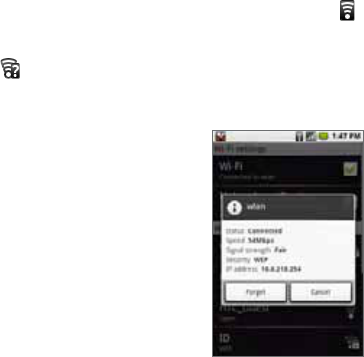
122 Getting Connected
To check the wireless network status
You can check the current wireless connection status from the following:
Status bar
When your phone is connected to a wireless network, the Wi-Fi icon ( )
appears in the status bar and tells you the approximate signal strength
(number of bands that light up). If Network notification in Wi-Fi settings is
enabled, this icon appears in the status bar whenever the phone detects
an available wireless network within range.
Wi-Fi networks
On the Wireless controls screen, touch Wi-Fi
settings, then touch the wireless network
that the phone is currently connected to.
The Wi-Fi network name, status, speed,
signal strength, security information, and IP
address are displayed.
Note If you want to remove the wireless
network settings on your phone, touch
Forget on this window. You need to enter
the settings again if you want to connect
to this wireless network.
•
•
Getting Connected 123
To connect to another Wi-Fi network
1. On the Wireless controls screen, touch Wi-Fi settings. Detected Wi-Fi
networks are displayed in the Wi-Fi networks section.
Tip To manually scan for available Wi-Fi networks, on the Wi-Fi settings screen, press
MENU and then touch Scan.
2. Touch another Wi-Fi network to connect to it.
Note If the wireless network you want to connect to is not in the list of detected networks,
scroll down the screen, then touch Add a Wi-Fi network. Enter the wireless network
settings, then touch Save.
6.2 Using Browser
Open Browser to start surfing the web. Browser is fully optimized and comes with
advanced functionalities that let you enjoy Internet browsing on your phone.
Note You must have an active data (3G, GPRS), or Wi-Fi connection to access the Internet.
To open Browser
Do one of the following:
Press HOME, then touch Browser.
Press HOME, then touch the Applications tab, and then touch Browser.
Note Browser automatically opens when you touch a web link in an email or text message.
•
•
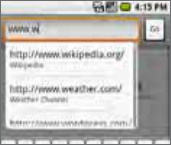
124 Getting Connected
To go to a web page
On the Browser screen, press MENU and then touch Go to URL.
2. Enter the web page address using the
keyboard. As you enter the address,
matching web page addresses will appear
on the screen. Touch an address to go
directly to that web page or continue
entering the web page address.
3. Touch Go.
To set your home page
Press MENU and then touch More > Settings > Set home page.
2. Enter the URL of the web site you want to use as your home page and then
touch OK.
View web pages
Browser offers a host of features that let you view web pages just like on a desktop
computer.
To change the screen orientation
The phone automatically changes the screen orientation depending on how you
are holding your phone.
Note The Orientation check box in Home> MENU > Settings > Sound & display needs to
be selected for the screen orientation to automatically change.
1.
1.

Getting Connected 125
To navigate on a web page
You can roll the TRACKBALL or slide your finger on the screen in any direction to
navigate and view other areas of the web page.
You can also use scale and scroll to magnify an area of the web page for easy
viewing. To use scale and scroll:
1. On a web page, press the TRACKBALL twice. The web page zooms out to fit
the height of the screen and the magnifying window appears.
2. Touch and hold the magnifying window, then drag it to the area of the page
that you want to view more closely. You can also roll the TRACKBALL to move
the magnifying window on any area of the screen.
Magnifying window
3. Release your finger or press the TRACKBALL to magnify the view. The view is
magnified using the zoom ratio used when you activated scale and scroll.
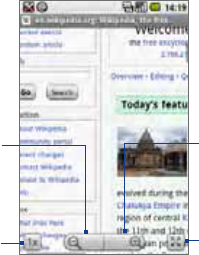
126 Getting Connected
To zoom in or out on a web page
Slide your finger to one direction on the screen to activate the zoom controls.
Touch to activate
scale and scroll.
Touch to resize the web
page to its actual size.
Touch to zoom in.
Touch to zoom out.
To open a new browser window
Open multiple browser windows to make it easier for you to switch from one web
site to another. You can open up to 8 browser windows.
To open a new window, press MENU and then touch New window while browsing
a web page. A new browser window opens and goes to the home page that is set.
Note If you have two or more browser windows opened, press MENU and then touch
Windows to let you add more browser windows.
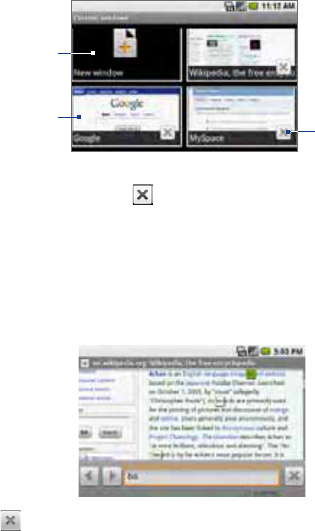
Getting Connected 127
To switch between browser windows
1. On a browser window, press MENU and then touch Windows.
Touch to open
a new web
page.
Touch to
close the web
page.
Touch to
display the
web page in
full screen.
2. On the Current windows screen, touch the browser window you want to view.
To close a browser window, touch on the browser window you want to close.
To find text within a web page
1. While viewing a web page, press MENU and then touch More > Find on
page.
2. Enter the search item. As you enter characters, matching characters will be
highlighted in green. Touch the left or right arrow to go to the previous or
next matching item.
Tip Touch to close the search bar.
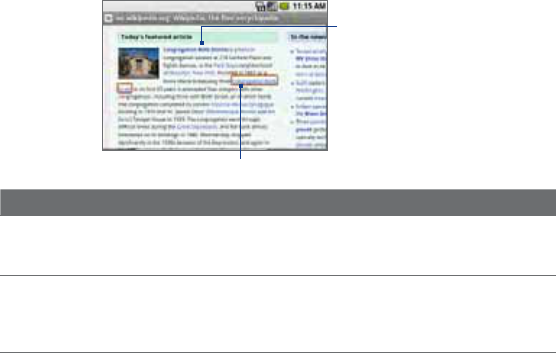
128 Getting Connected
Manage links, history, and downloads
To select links in web pages
Navigate to links on a web page using the TRACKBALL. Links are enclosed in an
orange or green box when selected.
Link is selected
Link is not selected
Link What to do
Web page address
(URLs)
Touch the link to open the web page.
Touch and hold the link to open a menu that allows you to open,
bookmark, copy to the clipboard, or share the link via email.
•
•
Email address Touch to send an email message to the email address.
Touch and hold, then touch Copy on the menu to copy the email
address to the clipboard. You can paste the email address later when
creating a new contact or sending a new email message.
•
•
Browser also recognizes some phone numbers and addresses that allow you to
call the phone number or locate the address in Google Maps™. Recognized phone
numbers and addresses are highlighted in green when navigated to.

Getting Connected 129
Link What to do
Location address Touch the address to open Google Maps and locate the address.
Phone number Touch to open the Phone screen to call the phone number.
Tip When links are too small for touching directly on the screen, highlight it with the
TRACKBALL, then either press the TRACKBALL to open the link, or press and hold the
TRACKBALL to select an option from the menu.
To allow download of web applications
Before you can download web applications, you must first enable downloading
from the phone settings.
Press HOME > MENU, and then touch Settings > Applications.
Select the Unknown sources check box.
When the Attention dialog box opens, touch OK.
Note All downloaded applications are saved to the storage card. Before you download an
application from the web, make sure that you have installed a storage card on your
phone. For information on how to install a storage card, refer to Chapter 1.
Warning! Applications downloaded from the web can be from unknown sources.
To protect your phone and personal data, download applications only from
trusted sources such as Android Market. Refer to “Installing Applications from
Android Market” in Chapter 9 for details.
To view your downloads
On a browser screen, press MENU and then touch More > Downloads.
1.
2.
3.
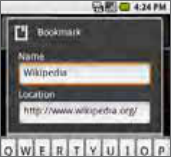
130 Getting Connected
Manage bookmarks
You can store as many bookmarks as you want on your phone.
To bookmark a web page
On a browser screen, go to the web page you
want to book mark.
Press MENU and then touch Bookmarks. The
bookmarks screen opens.
On the Bookmarks tab, touch Add bookmark
on the top of the screen.
Edit the bookmark Name if needed and then
touch OK.
1.
2.
3.
4.
To open a bookmark
On the Browser screen, press MENU and then touch Bookmarks.
On the Bookmarks tab, do one of the following:
Touch the bookmark you want to open.
Touch and hold the bookmark you want to open, then touch Open or
Open in new window on the options menu.
To edit a bookmark
On the Browser screen, press MENU and then touch Bookmarks.
On the Bookmarks tab, touch and hold the bookmark you want to edit.
Touch Edit bookmark on the options menu. The edit bookmark dialog box
appears.
Enter your changes and touch OK.
1.
2.
•
•
1.
2.
3.
4.

Getting Connected 131
6.3 Using Bluetooth
Bluetooth is a short-range wireless communications technology that allows
Bluetooth devices to exchange information over a distance of about eight meters
without requiring a physical connection.
Bluetooth on your phone operates in three different modes:
On. Bluetooth is turned on. Your phone can detect other Bluetooth-enabled
devices, but not vice versa.
Discoverable. Bluetooth is turned on, and all other Bluetooth-enabled
devices can detect your phone.
Off. Bluetooth is turned off. In this mode, you can neither send nor receive
information using Bluetooth.
Notes • By default, Bluetooth is turned off. If you turn it on, then turn off your phone,
Bluetooth also turns off. When you turn on your phone again, Bluetooth
automatically turns on.
•Turn off Bluetooth when not in use to conserve battery power, or in places where
using a wireless device is prohibited, such as on board an aircraft and in hospitals.
To turn on Bluetooth and make the phone discoverable
Press HOME > MENU, and then touch Settings.
Touch Wireless controls, then select the Bluetooth check box to turn on
Bluetooth. When on, the Bluetooth ( ) icon appears in the status bar.
Touch Bluetooth settings, then select the Discoverable check box to make
the phone discoverable to other Bluetooth devices that are within range.
Important Your phone will be discoverable for up to two minutes.
•
•
•
1.
2.
3.

132 Getting Connected
To change the phone name
The phone name identifies your phone in a Bluetooth network.
Make sure that you have turned Bluetooth on.
On the Wireless controls screen, touch Bluetooth settings > Device name.
Enter the name for your phone in the dialog box, then touch OK.
To pair and connect a Bluetooth hands-free headset or car kit
You can connect your phone to a Bluetooth hands-free headset or a Bluetooth
car kit and use those devices to send and/or receive calls. Before you can use a
Bluetooth hands-free headset or car kit, you must pair it first with your phone.
Important The phone supports the following Bluetooth profiles: Headset, Handsfree,
A2DP, and AVRCP.
1. Press HOME > MENU, and then touch Settings.
2. Touch Wireless controls > Bluetooth settings and then select the
Bluetooth check box. Your phone will start to scan for Bluetooth devices
within range and will display all detected devices below the Bluetooth
devices section.
Tips • If you do not find the device in the list, touch Scan for devices to scan again.
• Make sure that the Bluetooth device that you want to pair with is set to
discoverable mode. Consult the Bluetooth device’s documentation to learn how to
set it to discoverable mode.
3. Touch the hands-free headset or car kit in the list to start pairing.
Note For some Bluetooth devices, you need to enter a passcode to pair with the
Bluetooth device. You can try “0000” as the passcode. If that does not work,
consult the Bluetooth device’s documentation.
4. The pairing and connection status will appear below the hands-free headset
or car kit name in the Bluetooth devices list. When the other Bluetooth hands-
free headset or car kit is connected to your phone, the Bluetooth connected
icon will appear in the status bar. You can now start using the hands-free
headset or car kit to make and/or receive phone calls.
1.
2.
3.
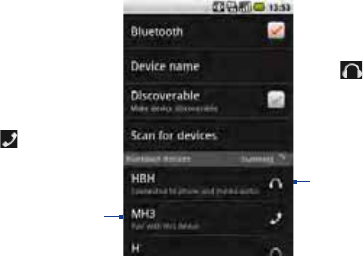
Getting Connected 133
The icon represents
that the device is
a stereo Bluetooth
headset (A2DP
Bluetooth profile).
You need to use a stereo
Bluetooth headset
(A2DP Bluetooth
profile) if you want to
listen to music through
a Bluetooth headset.
The icon
represents that the
device is a mono
Bluetooth headset
(Headset and
Handsfree Bluetooth
profiles).
Notes • Pairing between two Bluetooth devices is a one-time process. Once pairing is
created, the devices can recognize the partnership and exchange information
without entering a passcode again.
• If you pair with a second headset while connected to the first, the first headset
will be disconnected. To switch connection back to the first headset, you must
manually select that headset again in the Bluetooth devices list.
To disconnect a Bluetooth hands-free headset or car kit
Press HOME > MENU, and then touch Settings.
Touch Wireless controls > Bluetooth settings.
Navigate to the Bluetooth devices section, then touch and hold the
connected hands-free headset or car kit.
4. Touch Disconnect.
Touch Unpair if you want the phone to erase all pairing information with the
hands-free headset or car kit. You will be prompted to enter the passcode again
when you connect to that Bluetooth device.
1.
2.
3.
134 Getting Connected

Chapter 7
Getting Around with Maps
7.1 Using Maps
7.2 Searching for Places of Interest
7.3 Viewing Maps
7.4 Getting Directions
7.5 Finding your friends with Google Latitude
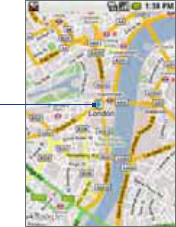
136 Getting Around with Maps
7.1 Using Maps
Maps lets you track your current location, view real-time traffic situations, and
receive detailed directions to your destination. It also provides a search tool where
you can locate places of interest or an address on a vector or aerial map, or view
locations in street level.
Notes • You need an active data (3G/GPRS) or Wi-Fi connection to use Maps.
•The Maps application does not cover every country or city.
To enable Location source
Before you open Maps and find your location or search for places of interest, you
must enable My location sources.
Press HOME > MENU and then touch Settings > Location.
Select Use wireless networks,Enable GPS satellites, or both.
Note Selecting GPS satellites lets you locate places of interest in street-level. However,
this requires a clear view of the sky and more battery power.
To open Maps
Do one of the following:
Press HOME, then touch Maps.
Press HOME, touch the Applications tab
and then touch Maps.
To find your location on the map
On the Maps screen, press MENU and then
touch My Location. Your location is shown on
the map as a blinking blue dot.
•
•
Your current
location
1.
2.
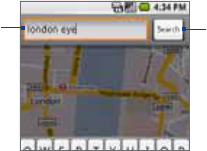
Getting Around with Maps 137
7.2 Searching for Places of Interest
To search for a place of interest
On the Maps screen, press MENU and then touch Search.
Enter the place you want to search in the search box. You can enter an
address, a city, or type of business or establishment (for example, museums
in london).
Enter the place
you want to
search here.
Touch to search
the place you
entered.
Tip As you enter information, a list of all the places which you have searched or
visited before appears on the screen. You can also touch an address on the menu
to show its location on the map.
3. Touch Search.
4. Touch a place in the list to show its location on the map.
1.
2.
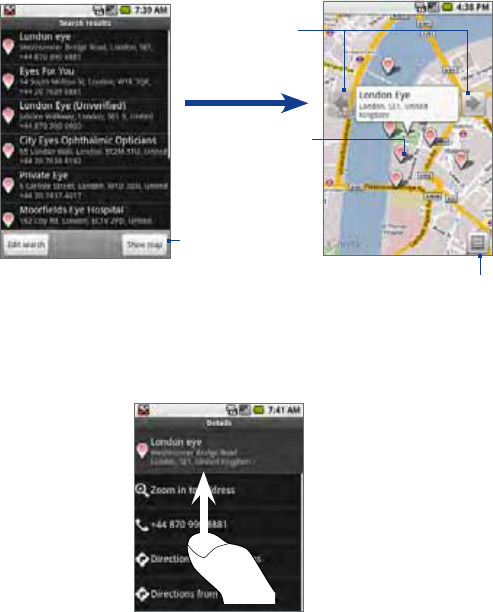
138 Getting Around with Maps
Touch to view the
location of the
previous or the next
place in the Search
results screen.
Touch to edit the search
or search for a new place.
Touch the place or
touch Show map to
show the location of
the place on the map.
Touch to return to the Search
results screen.
Location of one of the
places in the Search
results list.
Tip On the map, roll the TRACKBALL left or right to view the location of the previous
or the next place in the Search results list.
5. Touch the callout on the map to open the location details and options.
Scroll your finger up
the screen or roll the
TRACKBALL down to
view more location
options.
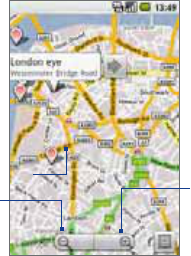
Getting Around with Maps 139
7.3 Viewing Maps
While viewing a map, take advantage of the following zoom and navigation
techniques.
To zoom in or out on a map
Touch the screen to show the zoom controls.
Touch to zoom out
on the map.
Zoom controls
Touch to zoom in
on the map.
To navigate on a map
Roll the TRACKBALL or slide your finger on the screen in any direction to view other
areas of the map.
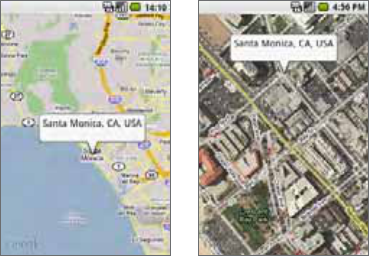
140 Getting Around with Maps
To change a map mode
When viewing a map, you can switch to another map mode. Press MENU and then
touch Map mode. Select from Map,Satellite,Traffic, or Street View.
Map mode Satellite mode
Map mode This is the default view and displays a map, complete with names
of streets, rivers, lakes, mountains, parks, and boundaries.
Satellite mode Maps uses the same satellite data as Google Earth. Satellite
images are not real-time. Google Earth acquires the best imagery available,
most of which is approximately one to three years old.
•
•
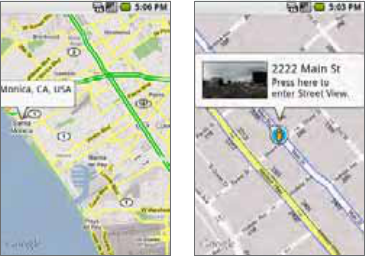
Getting Around with Maps 141
Traffic mode Street View mode
Traffic mode (available only in selected areas) Real-time traffic conditions
are displayed over roads as color-coded lines. Each color represents how fast
the traffic is moving.
Street View mode (available only in selected areas) Provides a street-level
view of the location. Blue outlined roads indicate that street view is available
on those locations.
While viewing a Street View of a location, press MENU and then touch
Compass mode to turn Compass mode on. Tilt, pan, or turn your phone to
view the area around the selected location.
•
•
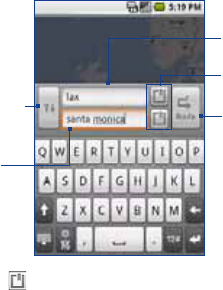
142 Getting Around with Maps
7.4 Getting Directions
Use Maps to get detailed directions to your destination.
To get directions
While viewing a map in any mode (except in Street View), press MENU and
then touch Directions.
Enter the starting point in the first text box, then enter your destination in
the second text box.
Touch to switch
your starting point
and destination.
Starting point
Touch to
generate a
route to your
destination.
Destination
Touch to open
the location
source menu.
You can also touch to open the location source menu and select a starting
point and destination address.
3. Touch Route. The directions to your destination appears in a list.
1.
2.
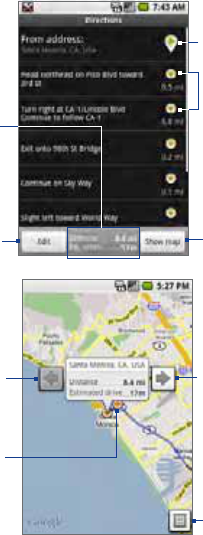
Getting Around with Maps 143
Touch to show
the directions
on a map.
Touch to
change your
route.
Touch to show the
location on a map.
Next turn
information
Distance and time
to destination.
Touch to
show the
previous turn
on the map.
Touch to display
the directions in
a list.
Touch to show
the next turn
on the map.
Next turn
When you are finished viewing or following the directions, press MENU and then
touch Clear map to reset the map. Your destination is automatically saved in the
Maps history.

144 Getting Around with Maps
7.5 Finding your friends with Google Latitude
Google Latitude™ user location service lets you and your friends share locations and
status messages with each other. It also lets you send instant messages and emails,
make phone calls, and get directions to your friends’ locations.
Your location is not shared automatically. You must join Latitude, and then invite
your friends to view your location or accept their invitations.
Open Latitude
To join Latitude
1. While viewing a map in any mode (except in Street View), press MENU and
then touch Join Latitude.
2. Read the privacy policy. If you agree with it, touch Agree & share.
To open Latitude after joining
While viewing a map in any mode (except in Street View), press MENU and then
touch Latitude.
Share your locations
After you join Latitude, you can start sharing your locations with your friends. Only
friends that you have explicitly invited or accepted can see your location.
Invite friends
To share your location with friends and request to see their locations
1. In Latitude, press MENU and then touch Add friends.
2. Choose how to add friends:
Select from Contacts. Select any number of friends from your Contacts.
Friends who already use Latitude have a icon next to their names.
Add via email address. Enter an email address.
•
•
Getting Around with Maps 145
3. Touch Add friends.
4. Touch OK.
If your friends already use Latitude, they receive an email request and a
notification on Latitude. If they have not yet joined Latitude, they receive an
email request that tells them to sign in to Latitude with their Google Account.
Accept an invitation
When you get a sharing request from a friend, you can:
Accept and share back. You can see your friend’s location, and your friend
can see yours.
Accept, but hide my location. You can see your friend’s location, but they
can’t see yours.
Don’t accept. No location information is shared between you and your friend.
You can change how your location is shared with each friend at any time. Refer to
“To share your location with friends and request to see their locations” earlier in this
chapter for more details.
•
•
•

146 Getting Around with Maps
Show your friends
You can show your friends using the map view or the list view.
Map view
When you open Google Maps, it shows your friends’
locations. Each friend is represented by a photo icon
with an arrow pointing at his or her approximate
location. If a friend has opted to enable city-level
sharing, his or her icon will not have an arrow and it
appears in the middle of the city. Refer to “To share
your location with friends and request to see their
locations” earlier in this chapter for more details.
To see your friend’s profile and connect with him or
her, touch the photo. This will display your friend’s
name, then touch the balloon right above his or her
icon.
To see other friends, touch either one of the arrow
buttons next to the balloon.
List view
To show a list of your friends, in Maps, press MENU
and then touch Latitude.
To see a friend’s profile and connect with him or her,
select your friend’s name from the list.

Getting Around with Maps 147
Connect with your friends
Touch a friend’s contact details balloon in map view or touch a friend in list view
to open the friend’s profile. In the profile screen, you can communicate with your
friend and set privacy options.
Options Description
Show on map Find a friend’s location on the map.
Chat using Google Talk Send an instant message. Google Talk opens a chat window with
that friend.
Send email Send an email. Gmail/Google Mail opens an email addressed to
that friend.
Directions Get directions to the friend’s location.
Hide from this friend Stop sharing your location with this friend. Your friend cannot
see your photo icon on the map. To share your location with this
friend again, touch Unhide from this friend.
Share only city level
location
Share only the city you are in, not the street-level location. Your
friend can see your photo icon in the middle of the city you are
in.
To share more precise location again, touch Best available
location.
Remove Remove the friend from your list and stop sharing locations with
him or her altogether.
Control what you share
You have control over how and when you can be found by your friends. Only the
last location sent to Latitude is stored with your Google Account. If you turn off
Latitude or are hiding, no location is stored.

148 Getting Around with Maps
To change your public profile
1. In Maps, press MENU, touch Latitude, and then touch your contact details
balloon.
2. Set the following options to your preferences.
Options Description
Show on map See your location on a map.
Change your status Change the status message, which is shared across other Google
products and features, such as Google Talk and Gmail/Google Mail.
After you touch Change your status, type your new status in the
dialog box, and then touch OK.
Change your photo Change the picture, which is also shared across other Google
products and features.
After you touch Change your photo, you can either take a picture
of yourself with the phone or select a picture from Gallery. Refer to
“Using Camera” and “Using Gallery” in Chapter 8 for more details.
Edit privacy setting Manage how your location is shared with all your friends. Select one
of the following options:
Detect your location. Let Latitude automatically detect and
update your location as you move around. The update frequency is
determined by several factors, such as your phone’s battery charge
level and how recently your location has changed.
Note You must have My location sources enabled. To learn how to
enable My location sources, refer to “Using Maps” in this chapter.
Set your location. Manually select a location on the map.
Hide your location. Hide your location from all your friends. They
will not be able to see your location on their maps. You can also hide
your location only to certain individuals.
Turn off Latitude. Disable Latitude and stop sharing. Your friends
cannot see your location. You can always join Latitude again.

Chapter 8
Camera, Multimedia, and Documents
8.1 Using Camera and Camcorder
8.2 Using Gallery
8.3 Using YouTube
8.4 Using Music
8.5 Viewing PDF Files
8.6 Using Quickoffice
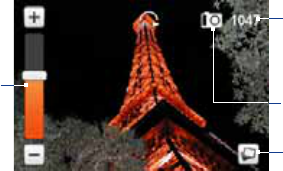
150 Camera, Multimedia, and Documents
8.1 Using Camera and Camcorder
Use Camera or Camcorder to take and share pictures and videos. Your phone
comes with a 3.2 megapixel camera with auto-focus feature that lets you capture
sharp pictures and videos.
Before you proceed
You must install a storage card before you use Camera or Camcorder. All
pictures or videos that you capture on your phone are stored on the storage
card. For more information on how to install a storage card on your phone, refer
to Chapter 1.
The camera lens at the back of the phone is covered by a protective film
during shipment. Make sure that you peel this film off before using the
camera.
To open the Camera
Press HOME, touch the Applications tab and then touch Camera if you want to
capture photos or Camcorder if you want to shoot videos. The screen automatically
switches to landscape orientation when you open Camera or Camcorder.
Tip You can easily switch to the other capture mode while you are in Camera or
Camcorder. Refer to “Capture modes” in this chapter for details.
Zoom control
Remaining
available shots or
recording time
Touch to open
Gallery
Current capture
mode
•
•

Camera, Multimedia, and Documents 151
The camera controls disappear after a few seconds. To show the camera controls
again, touch the screen.
To close the Camera
On the Camera screen, press HOME or BACK.
Capture modes
The phone offers three capture modes: Photo, Video, and Contact picture.
To change the capture mode
1. On the Camera screen, press MENU and then touch / / .
Note The icon you see will depend on the capture mode you are in.
2. On the Capture mode options menu, select the capture mode you want to
use and then touch OK.
Take pictures
1. Switch to the Photo or Contact picture capture mode.
2. Frame your subject on the screen.
3. Press the TRACKBALL button. The auto-focus feature is turned on and then
automatically takes the shot after focus is set.
Auto-focus
indicator
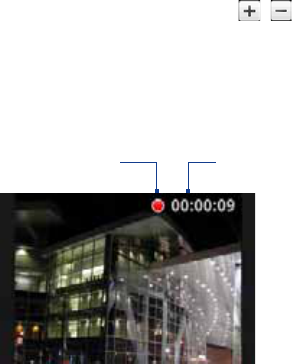
152 Camera, Multimedia, and Documents
Tip To zoom in, touch the screen to open the camera controls and then scroll the
TRACKBALL up or down (landscape orientation) to zoom in and out. You can also
touch and slide the Zoom control up and down or touch / to zoom in and out.
Shoot videos
1. Switch to the Video capture mode.
2. Frame your subject on the screen.
3. Press the TRACKBALL button to start capturing video. Press the TRACKBALL
again to stop capturing video.
Recording indicator Capture duration
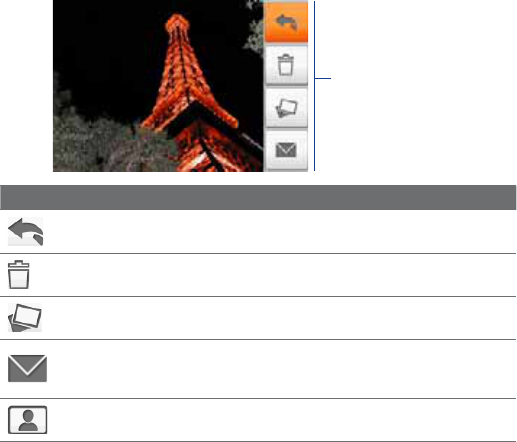
Camera, Multimedia, and Documents 153
Review screen
After capturing, the review screen lets you save, assign, send, or delete the picture
or video by touching a button at the right-side of the screen.
Review screen
buttons
Icon Function
Back Return to the live Camera or Camcorder screen.
Delete Delete the captured image or video.
View View the captured image or video in Gallery..
Send (Photo and Video modes only) Send the captured image or
video via email or MMS or set the captured image as your Home screen
wallpaper.
Assign to Contact (Contact picture mode only) Assign the photo to a
contact.
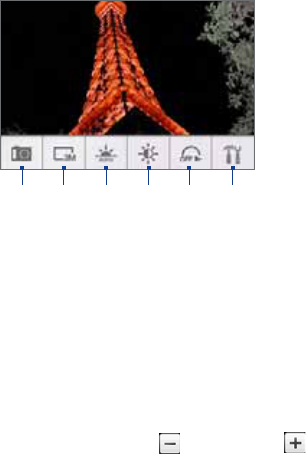
154 Camera, Multimedia, and Documents
Camera menu panel
The Camera menu panel lets you change the capture mode, adjust basic camera
settings, and access advanced camera settings.
12 3 45 6
To open the menu panel
While on the Camera screen, press MENU.
1Capture mode Touch to select the capture mode to use.
2Resolution Touch to change the resolution (capture size). When using
Contact Picture mode, there is only one available resolution.
3White Balance Touch to adjust the white balance. White balance enables
the camera to capture colors more accurately by adjusting to different
lighting conditions. White balance settings include: Auto,Daylight,Cloudy,
Incandescent, and Fluorescent.
4Brightness Touch to open the Brightness bar so you can adjust the
brightness. On the Brightness bar, touch to decrease, or to increase
the brightness level. Touch outside the Brightness bar to apply the change.
5Self-timer (Photo and Contact photo modes only) Touch to set the self-timer
to Off,2 seconds, or 10 seconds. When you press the TRACKBALL to take the
photo, it starts to count down, then takes the shot after the time expires.
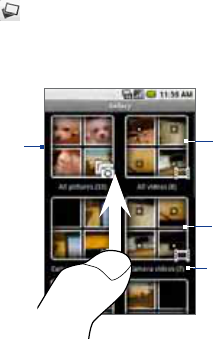
Camera, Multimedia, and Documents 155
6Advanced Touch to open the advanced camera settings. See “Advanced
settings” for details.
8.2 Using Gallery
Gallery lets you view photos and play back videos. For photos, you can also do
basic editing tasks, set them as your wallpaper or contact picture, and share to your
friends.
To open Gallery
Press HOME, touch the Applications tab and then touch Gallery.
While on the Camera screen, touch the screen to open the onscreen controls
and then touch .
If you stored your files in folders (directories) on the storage card, Gallery will
display these folders as separate albums. The top left album contains all the
pictures in the storage card.
Touch to view the
files inside the
album.
This album
contains all the
pictures inside
all the albums.
Album name
and number of
files inside.
Scroll up the
screen or roll
the TRACKBALL
down to view
more albums.
This album
contains all the
videos inside
all the albums.
•
•
156 Camera, Multimedia, and Documents
Note Depending on the number of pictures stored on the storage card, it may take a while
to load all your photos on the screen.
To close Gallery
While in the Gallery screen, press HOME or BACK to close the application.
Note If you opened Gallery from the Camera application, the screen returns to the Camera
screen when you press BACK.
Work with pictures
Once you have taken a picture, you can view it or share it with friends.
To view pictures
1. On the Gallery screen, touch an album to view the pictures inside the album.
Note If there are no picture albums, slide your finger upward or downward the screen,
or roll the TRACKBALL up or down to browse through individual pictures.
2. Touch a thumbnail to view it in full screen. You can also touch and hold the
thumbnail, then touch View on the options menu to open it.
Tip You can choose to display small or large thumbnails or sort your album and
display the latest pictures first or last. On the Gallery screen, press MENU and
then touch Settings. Navigate to the General settings section, touch Display
size or Sort order, then adjust the settings accordingly.
To browse through pictures
When viewing pictures in full screen, do one of the following:
Touch the left area of the screen to view the previous picture, or touch the
right area of the screen to view the next picture.
Touch the screen to display the scroll arrows. Touch the left arrow to view the
previous picture, or touch the right arrow to view the next picture.
Roll the TRACKBALL left to view the previous picture, or roll it right to view
the next picture in the album or in the pictures list.
•
•
•

Camera, Multimedia, and Documents 157
To zoom in or out on a picture
Touch the screen to activate the zoom control.
Touch to zoom out. Touch to zoom in.
To view a picture in landscape orientation
Turn your phone sideways to view the picture in landscape mode. The picture
orientation automatically adjusts to how you hold the phone.
Note The Orientation check box in Home> MENU > Settings > Sound & display needs to
be selected for the screen orientation to automatically change.
If you want to rotate the picture and save the rotated state, see “To rotate and save
the rotated state” below.
158 Camera, Multimedia, and Documents
To rotate and save the rotated state
1. In the Gallery screen, touch and hold the picture you want to rotate or if you
are viewing the picture in full screen, press MENU.
2. In the options menu, touch Rotate and then select either Rotate left or
Rotate right.
Note The Picture rotates 90 degrees counter-clockwise (Rotate left) or 90 degrees clockwise
(Rotate right) each time you touch one of the Rotate options.
To crop a picture
1. While viewing a picture in full screen, press MENU and then touch Crop. The
cropper tool appears.
2. Do one of the following:
To adjust the cropper size, touch and hold the edge of the cropper tool. When
the cropper arrows appear, drag your finger inward to or outward from the
centre of the cropper to resize it.
To keep the aspect ratio of the cropper while resizing, touch and hold one of
the 4 corners.
To move the cropper to another area on the picture, touch and hold inside
the cropper, then drag it with your finger to the desired position.
•
•
•
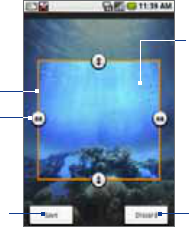
Camera, Multimedia, and Documents 159
Cropper tool
Touch to
save the
photo. Touch to discard
your changes.
Cropper arrow
Touch and hold
inside the cropper,
then drag it to any
area of the photo.
3. Touch Save to apply the changes to the picture.
Note The cropped picture is saved in the storage card as a copy. The original picture
remains unedited.
To send a picture using Mail
1. While viewing a picture in full screen, press MENU, then touch Share.
2. When prompted, touch HTC Mail or Gmail/Google Mail.
3. The picture is automatically attached to your email. Compose your message,
then touch Send. For more information on how to create and send emails,
refer to Chapter 5.
To send a picture using Messaging
1. While viewing a picture in full screen, press MENU, then touch Share.
2. When prompted, touch Messaging.
3. The picture is automatically attached to your message. Compose your
message, then touch Send. For more information on how to create and send
messages, refer to Chapter 5.

160 Camera, Multimedia, and Documents
To upload a picture to Picasa
You need to be signed in to a Google Account to be able to upload pictures to the
Picasa™ photo organizing service.
1. While viewing a picture in full screen, press MENU, then touch Share.
2. When prompted, touch Picasa.
3. Enter a Caption for the picture and select the Album where you want to
upload the picture.
Tip Touch to create a new album where you can upload the picture.
4. Touch Upload. You can view the photos online at http://picasaweb.google.
com.
Tip You can view the upload progress by opening the Notifications panel and then
touching Picasa. Refer to “To open the Notifications panel” in Chapter 1 to learn how
to open the Notifications panel.
Work with videos
Once you have taken a video, you can view it or share it with friends.
To watch videos
1. On the main Gallery screen, touch a video album and then touch the video
you want to watch to start playing back the video.
2. Touch the screen to show the playback controls.
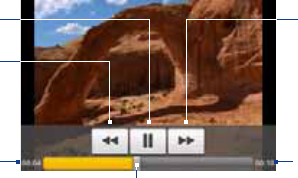
Camera, Multimedia, and Documents 161
Touch to toggle
between playing and
pausing the video.
Touch to go back
on the video.
Elapsed time Total time
Touch to go forward
on the video.
Drag to the left or right to go back
or forward in the video.
To send a video using Mail
1. While viewing videos in a list, touch and hold the video, and then touch
Share on the options menu.
2. When prompted, touch HTC Mail or Gmail/Google Mail.
3. The video is automatically attached to your email. Compose your message,
then touch Send. For more information on how to create and send emails,
refer to Chapter 5.
To send a video using Messaging
1. While viewing videos in a list, touch and hold the video, and then touch
Share on the options menu.
2. When prompted, touch Messaging.
3. The picture is automatically attached to your message. Compose your
message, then touch Send. For more information on how to create and send
messages, refer to Chapter 5.
162 Camera, Multimedia, and Documents
To share videos on YouTube
You can share your videos by uploading them to YouTube™. Before you do this, you
must create a YouTube account and sign in to that account on your phone.
1. While viewing videos in a list, touch and hold the video, and then touch
Share on the options menu.
2. When prompted, touch YouTube.
3. Enter a Title,Description, and Tags for your video. Select the Public check
box if you want to share the video with everyone.
4. Touch Upload.
Tip You can view the upload progress by opening the Notifications panel and then
touching YouTu b e. Refer to “To open the Notifications panel” in Chapter 1 to learn
how to open the Notifications panel.
8.3 Using YouTube
YouTube is a free online video streaming service that allows you to view videos that
have been uploaded by YouTube members.
Notes • You do not need a YouTube account to browse and view videos. However, to use all
the features of YouTube (such as viewing “My account”), you must create a YouTube
account from your computer and sign in to that account from your phone.
• You must have an active data (3G/GPRS/EDGE) or Wi-Fi connection to access
YouTube.
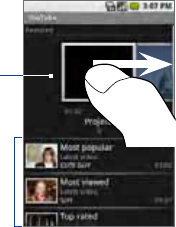
Camera, Multimedia, and Documents 163
To open YouTube
Press HOME, touch the Applications
tab and then touch YouTube.
The YouTube screen appears with the
videos grouped into categories, such
as Featured,Most popular, Most
viewed,Top rated, and more.
To close YouTube
While on the YouTube screen, press
HOME or BACK to close YouTube. Video categories
Featured videos.
Scroll your finger
to the right
to view more
featured videos.
Watch videos
On the YouTube screen, select a video to watch from the available categories.
Touch a category to see the available videos for that category.
Touch a video to play it.
Note The screen automatically switches to landscape orientation when you play a
video.
3. Touch the screen to display the playback controls.
1.
2.
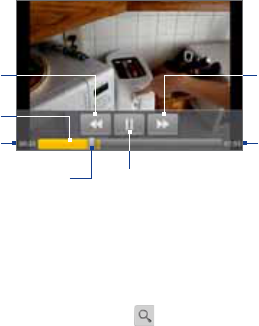
164 Camera, Multimedia, and Documents
Touch to toggle between
playing and pausing the video.
Drag to the left or right
to go backward or
forward in the video.
Progress bar
Elapsed time Total playback time
Touch and hold to
fast forward the
video.
Touch and hold
to rewind the
video.
4. Press BACK to stop playback and return to the videos list.
Search for videos
On the YouTube screen, press MENU and then touch Search.
Enter a search keyword, then touch .
The number of search results appears below the status bar. Scroll through the
results and touch a video to watch it.
To clear the search history
1. Press MENU and then touch Settings.
2. Touch Clear search history and then touch OK when prompted.
Share videos
You can share a video by sending its link to your contacts.
Do one of the following:
While viewing videos in a list, touch and hold the video, and then touch
Share on the options menu.
While watching a video, press MENU and then touch Share.
1.
2.
3.
1.
•
•
Camera, Multimedia, and Documents 165
Note If you have set up an external email account in addition to your Gmail/Google
Mail account, you will be prompted to select the email account to use to send
the video link.
A new email message appears with the video link automatically added to the
email message.
2. Compose your email then send it. For more information about composing
and sending emails, refer to Chapter 5.
8.4 Using Music
Music plays digital audio files from the phone’s storage card. Music supports the
following music file formats: MP3,M4A (iTunes application AAC, DRM-free), AMR,
WMA (8),MIDI,WAV,OGG Vorbis.
Since Music only plays audio files saved on the storage card of your phone, you
must copy your audio files to the storage card before you open Music.
To copy music into the storage card
1. Set the phone’s storage card as a USB drive. See “Using the Phone’s Storage
Card as a USB Drive” in Chapter 1 for details.
2. On the computer, navigate to the USB drive and open it.
3. Create a folder on the root folder of the storage card (for example, Music).
Tip You can also create and use folders to organize your music inside the Music
folder you have created.
4. Copy the music into the folder you have created.
5. After copying music, unmount or eject the drive as required by your
computer’s operating system to safely remove the phone.
6. Disconnect the phone from the computer.
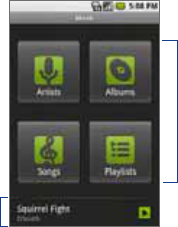
166 Camera, Multimedia, and Documents
To open Music
Press HOME, touch the Applications tab, and then touch Music. The Music library
screen displays.
Music library
Your music is organized into four categories: Artists,Albums,Songs, and Playlists.
Touch a category to view the list within each.
When inside a category, keep touching the screen until you reach the music
you want to play. For example, if you touch Artists, you will see a list of artists in
alphabetical order. If you touch an artist, the list opens to display the available
albums or music. Select an album and the album’s song list displays.
Music bar.
Appears when a music
file is currently playing.
Touch to open the
playback screen.
Touch a music
category to open
the music file you
want to play.
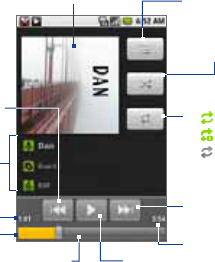
Camera, Multimedia, and Documents 167
Play music
At any level inside a Music library category, touch and hold an item (a song, artist,
album, or playlist) to open the options menu, then touch Play. The playback screen
opens.
Notes • Press the VOLUME UP or VOLUME DOWN button to adjust the playback volume.
• If you are using the wired headset to listen to music, press the button to toggle
between playing and pausing playback. Press and hold the button to go to the
next track on the playlist.
Playback screen
Touch and drag
to jump to any
part of the song.
Album cover art
Song information
Touch to turn shuffle on and off.
(Shuffle is off when button is gray.)
Touch to cycle through the repeat
modes:
Repeat all songs
Repeat the current song
Don’t repeat
•
•
•
Total playback time
Touch to pause or
to resume playing
the song.
Touch and hold to fast forward the
song.
Touch once to play the next song on
the album.
•
•
Elapsed time
Touch to view the current
playlist.
Touch and hold to
rewind the song.
Touch once to jump
to the beginning of
the song.
Touch twice to play
the previous song on
the album.
Progress bar
Tip While on the Music library or playback screen, you can play all songs in your library
in random order. Press MENU, then touch Party shuffle. The first randomly selected
song will play. To turn off Party shuffle, press MENU, then touch Party shuffle off.

168 Camera, Multimedia, and Documents
Use playlists
Use playlists to organize your music files. You can create as many playlists as you
want on your phone.
To create a playlist
Touch a category on the Music library screen.
In the list that appears, use the TRACKBALL to navigate to the artist, album, or
song that you want to add in the playlist.
Touch and hold the artist, album, or song, then touch Add to playlist on the
options menu.
In the Add to playlist window, touch New.
Tip If you want to add the artist, album, or song to an existing playlist, touch the
playlist’s name in the Add to playlist options menu.
5. Enter the name for your new playlist and then touch Save.
To manage your playlists
Go to the Music library screen and then touch Playlists.
Do one of the following:
To play the songs in a playlist, touch the playlist name.
To delete a playlist, touch and hold the playlist, then touch Delete.
To rearrange the songs or remove a song in a playlist, touch and hold the
playlist, then touch Edit on the options menu. Touch and hold before
the song you want to move, drag it to its new position, then release.
To delete a song in a playlist, touch and hold the song, then touch
Remove from playlist.
To rename a playlist, touch and hold the playlist, then touch Rename on
the options menu. Enter the new playlist name, then touch Save.
Note The Recently added playlist is a system playlist and cannot be deleted or renamed.
To import a playlist
1.
2.
3.
4.
1.
2.
•
•
•
•
•
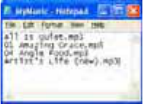
Camera, Multimedia, and Documents 169
You can create playlists on your computer, then save these on your storage card.
Music can access the following playlist formats: M3U,WPL, and PLS.
On your computer, open a simple text file for
editing.
On separate lines, enter all the music file
names you want to include in your playlist.
1.
2.
Notes • The names you list in the file should be the names that appear when you view the
contents of your storage card through your computer’s file system, not the names
that appear in the list of songs on your phone.
• Your phone will simplify the names and will not include track numbers or file
extensions (for example, .mp3).
3. Save the playlist file using .m3u as the file name extension (for example,
MyMusic.m3u).
4. Copy the playlist file to the Music folder on the storage card. Follow the
instructions in “To copy music into the storage card” section earlier in this
chapter.
Tip It is recommended that you create a Playlist folder inside your Music folder in
the storage card to hold all your playlist files.
170 Camera, Multimedia, and Documents
Set a song as ring tone
You can use songs as your phone ring tone.
1. From the Music library, navigate to the song that you want to use as ring
tone.
2. Touch and hold the song, then touch Use as phone ringtone on the menu.
The song is set as your default incoming call ring tone.
To check if the song was added as a ring tone
1. On the Home screen, press MENU and then touch Settings.
2. On the Settings screen, touch Sound & display > Phone ringtone. The song
should be listed as an option.
Delete music on the storage card
You can delete music files on the storage card.
On the Music Library screen, touch Artists,Album, or Songs.
Touch and hold the artist, album, or song you want to delete, then touch
Delete on the options menu.
When prompted, touch OK.
1.
2.
3.
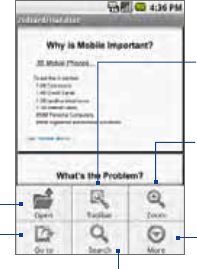
Camera, Multimedia, and Documents 171
8.5 Viewing PDF Files
Copy PDF files to the storage card of your phone and then use PDF Viewer to view
them.
To open a PDF file
1. On the Home screen, touch the Applications tab and then touch PDF Viewer.
2. On the Open file screen, touch the file you want to view.
To view a PDF file
Slide your finger on the screen to pan or go through the pages of the PDF file. While
viewing a PDF file, press MENU to let you open another PDF file, zoom in, search the
file, and more.
Touch to zoom in on
the page. You can also
double-tap the screen
to zoom in or out of the
page.
Touch to view
file properties or
information about the
PDF Viewer.
Touch to toggle between
showing and hiding the
page toolbar.
Touch to open
another PDF file.
Touch to go to a
specific page on
the PDF file.
Touch to search for a
word in the PDF file.
Turn your phone sideways (turn to the left) to view the PDF file in landscape mode.
The screen orientation automatically adjusts depending on how you hold the
phone.
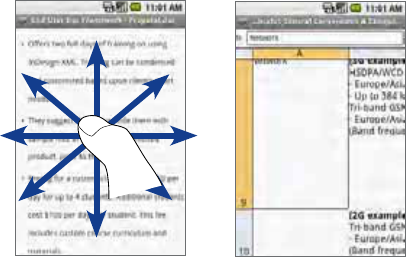
172 Camera, Multimedia, and Documents
8.6 Using Quickoffice
Quickoffice lets you view Microsoft Office Word and Microsoft Office Excel files
on your phone. Quickoffice supports viewing of Microsoft Office 2003 Word (.doc),
Excel (.xls), and text (.txt) files.
To open files
Make sure you have copied the files to the phone’s storage card before you open
Quickoffice.
1. On the Home screen, touch the Applications tab, and then touch Quickoffice.
2. Touch Memory card and then touch the file you want to open.
Tip While on the Memory card screen, press MENU and then touch Sort by to let you
sort the list by Name,Type,Size, or Date Modified.
To view files
Slide your finger on the screen to pan or go through the pages of the file.
Camera, Multimedia, and Documents 173
While viewing a file, you can:
Slide your finger on the screen to bring up the zoom controls.
For Excel files, press MENU and then touch Worksheet to view other
worksheets on the file.
For Excel and Word files, touch a URL link to open the web page in Browser.
•
•
•
174 Camera, Multimedia, and Documents

Chapter 9
Using Android Market
9.1 Using Android Market
9.2 Getting Help
9.3 Finding Applications
9.4 Installing an Application
9.5 Managing Applications
9.6 Uninstalling an Application
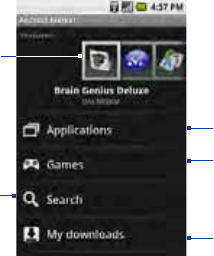
176 Using Android Market
9.1 Using Android Market
Android Market provides direct access to useful applications and fun games which
you can download and install on your phone. Android Market also allows you to
send feedback and comments about an application, or flag an application that you
find objectionable or incompatible with your phone.
To open Android Market
1Press HOME, then touch the Applications tab, and then touch Market.
2When you open Android Market for the first time, the Terms of Service
window will appear. Touch Accept to continue.
Touch to open
the application
details screen.
Touch a category to
open a sub-category
and view more
applications.
Touch to search
Android Market.
Touch to view your
downloads.
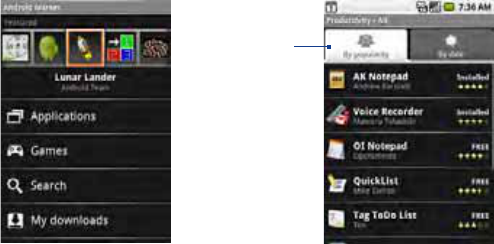
Using Android Market 177
9.2 Getting Help
If you ever need help or have questions about Android Market, press MENU and
touch Help. The Browser will take you to the Android Market Help webpage.
9.3 Finding Applications
The Android Market home page provides several ways to find applications.
It showcases featured applications and includes a list of item applications by
category, a list of games, a link to search, and a link to My downloads.
Scroll horizontally through the featured items or select a category to browse its
contents, then select a subcategory. Within each subcategory you can select to
view items sorted By popularity or By date.
Touch the tab to
sort by popularity
or date.
Note All items in a subcategory are listed in each tab; those in the By popularity tab are
sorted from most popular to least popular, and those in the By date tab are sorted
from newest to oldest
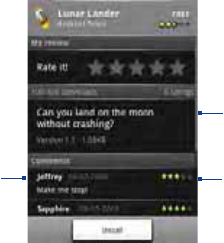
178 Using Android Market
9.4 Installing an Application
To install and open an application
1Navigate to the item you want to download, and select it.
2In the item details screen, read more about the application, including its
overall rating, and comments by users. If you scroll down to the About the
developer section, you can view more applications by this developer, visit the
developer’s website, and send the developer an email message.
Important Press MENU and select Security permissions to view the functions and data
this item can access on your phone.
Scroll down to view
more of this developer’s
applications or to email
the developer.
User comments
about item.
More info about item.
Touch and hold a
comment to let you
report a comment
as spam.
3On any application details screen, touch Install.
Important If the application requires either access to any of your data or control of any
functions on your phone, Market tells you what the application can access.
Read it carefully! Be especially cautious with applications that have access to many functions
or a significant amount of your data. Once you touch OK on this screen, you
are responsible for the results of using this item on your phone. Touch OK if
you agree to the conditions of the application.
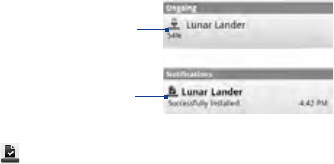
Using Android Market 179
4. To check the progress of the download, open the Notifications panel. Most
applications are installed within seconds. If you want to stop downloading
the item, touch Cancel download.
Download progress appears
in the Ongoing section of the
notifications window.
Once downloaded
and installed, a
notification appears.
5. After the item is downloaded and installed on your phone, the content
download icon appears in the notification area of the status bar.
6. On the Android Market screen, touch My downloads.
7. Touch the installed application in the list, then touch Open.
Tip You can also find the icon of the installed application on the Applications tab.
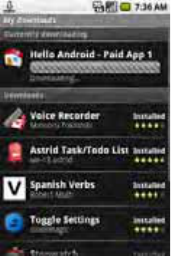
180 Using Android Market
9.5 Managing Applications
From the Android Market Home, touch My downloads to view your downloaded
items. From any of the Android Market screens, press MENU and touch My
downloads to go to the screen.
9.6 Uninstalling an Application
To uninstall an application
You can uninstall any application that you have downloaded and installed from
Android Market.
1On the My downloads screen, touch the application you want to uninstall,
then touch Uninstall.
2When prompted, touch OK to remove the application on your phone.
3Choose the reason for removing the application, then touch OK.

Chapter 10
Managing Your Phone
10.1 Changing Basic Settings
10.2 Protecting Your Phone
10.3 Managing Memory
10.4 Synchronizing Google Apps
10.5 Resetting the Phone

182 Managing your Phone
10.1 Changing Basic Settings
Set the date, time zone, and time
By default, your phone automatically uses the network-provided date, time zone,
and time.
To manually adjust the date, time zone, and time
1. Press HOME > MENU, and then touch Settings.
2. Scroll down the screen, then touch Date & time.
3. Clear the Automatic check box.
4. Touch Set date. On the Change date window, touch or to adjust the
date, month, and year, then touch Set when finished.
5. Touch Set time zone, then select the time zone in the list. Scroll down the list
to view more time zones.
6. Touch Set time. On the time window, touch or to adjust the hour
and minute, then touch AM to change to PM or vice versa. Touch Set when
finished.
7. Select the Use 24-hour format check box to toggle between using a 12-hour
or a 24-hour format.
8. Touch Select date format then select how you want dates to display on your
phone. The selected date format also applies to the date displayed in the
Alarm Clock.
Note For details on how to set an alarm, see “Using Alarm Clock” in Chapter 4.
Managing your Phone 183
Display settings
To adjust the screen brightness
1. Press HOME > MENU, and then touch Settings.
2. Touch Sound & display, scroll down the screen, then touch Brightness.
3. Drag the brightness slider to the left to decrease or to the right to increase
the screen brightness.
4. Touch OK.
To adjust the time before the screen turns off
After a period of inactivity, the phone screen turns off to conserve battery power.
You can set the idle time before the screen turns off.
1. Press HOME > MENU, and then touch Settings.
2. Touch Sound & display.
3. Scroll down the screen, then touch Screen timeout.
4. Select the time before the screen turns off, then touch OK.
Tip To turn off the screen quickly, press the END CALL/POWER button.
To prevent the screen orientation from automatically changing
By default, the screen orientation automatically adjusts depending on how you
hold the phone.
1. Press HOME > MENU, and then touch Settings.
2. Touch Sound & display.
3. Scroll down the screen, then clear the Orientation check box.
To keep the screen on while charging the phone
You can keep the phone from turning off the screen while you are charging the
phone.
1. Press HOME > MENU, and then touch Settings.
184 Managing your Phone
2. Touch Applications >Development and then select the Stay awake
check box.
Ringer settings
To change the ring tone
1. Press HOME > MENU, then touch Settings.
2. Touch Sound & display > Phone ringtone.
3. Touch the ring tone you want to use, then touch OK. The ring tone briefly
plays when selected.
Tip You can use *.wav, *.mid, *.mp3, *.wma, or other types of sound files that you
downloaded from the Internet or copied from your computer as ring tones. For a
complete list of supported audio file formats for ring tones, see “Specifications” in the
Appendix.
To enable touch tones
You can set the phone to play a sound when you are using the phone pad and/or
touching the screen.
1. Press HOME > MENU, then touch Settings.
2. Touch Sound & display, then scroll down the screen.
3. Select the Audible touch tones and/or Audible selection option(s).
To choose the notification ring tone
You can select the ring tone to play when your phone receives new notifications.
1. Press HOME > MENU, then touch Settings.
2. Touch Sound & display > Notification ringtone.
3. Select your preferred notification ring tone in the list and then touch OK.
Managing your Phone 185
Phone services
Your phone can directly link to the mobile phone network, and enable you to
access and change the settings of various phone services for your phone. Phone
services may include Call Forwarding, Call Waiting, Voicemail, and more. Contact
your wireless service provider to find out about the availability of phone services for
your phone.
To access and change the phone services settings
1. Press HOME > MENU, then touch Settings.
2. Touch Call settings.
Note For more information about the phone services on your phone, refer to the “Adjusting
Phone Settings” in Chapter 2.
To enable data roaming
Data roaming lets you connect to your wireless service provider’s partner networks
and access data services when you are out of your wireless service provider
coverage area.
1. Press HOME > MENU, then touch Settings.
2. Touch Wireless controls >Mobile networks.
3. Select the Data roaming option.
Important Accessing data services while roaming may incur significant charges. Inquire
the data roaming tariffs with your wireless service provider before enabling
data roaming.
Language settings
You can change the operating system language of the phone.
To change the language of the operating system
1. Press HOME > MENU, then touch Settings.
2. Touch Locale & text > Select Locale and then select the language you want
to use.
186 Managing your Phone
10.2 Protecting Your Phone
Protect your SIM card with a PIN
You can protect your SIM card from unauthorized use by assigning a PIN (personal
identification number).
To enable the SIM card PIN
1. Press HOME > MENU, then touch Settings.
2. Touch Security, scroll down the screen, then touch Set up SIM card lock.
3. Select the Lock SIM card option.
4. Enter the default SIM card PIN using the keyboard, then touch OK.
5. To change the SIM card PIN at any time, touch Change PIN code.
Tip Emergency calls can be placed at any time, without requiring a PIN.
To restore a SIM card that has been locked out
If you enter the wrong PIN more times than the maximum number of attempts
allowed, your SIM card will become “PUK-locked.” You need a new PUK code to
restore access to the device. This code may have been provided by your operator
when you received your SIM card.
Touch Emergency Dial and enter the following sequence on the keypad:
* * 0 5 * [PUK code] * [new PIN] * [new PIN] #
For example, if your PUK code is 888888 and you would like to reset the
PIN on your SIM card to 7777, enter the following into Emergency Dial:
**05*888888*7777*7777#.
Managing your Phone 187
Protect your phone with a screen lock
You can further secure your data by locking the screen and/or requiring a screen
unlock pattern every time your phone is turned on or every time it wakes up from
sleep mode (screen is off).
To lock the screen
Press the END CALL/POWER button. Locking the screen prevents accidental screen
touches when the phone is in your bag, purse, or pocket.
Note To unlock the screen, press one of the buttons in front of the phone, and then press
MENU.
To create and enable the screen unlock pattern
You can increase the security of your phone by creating a screen unlock pattern.
When enabled, you have to draw the correct unlock pattern on the screen to unlock
the phone’s control buttons and touch screen.
1. Press HOME > MENU, then touch Settings.
2. Touch Security > Set unlock pattern.
3. Read the information on the screen, then touch Next.
4. Study the example pattern on the screen, then touch Next.
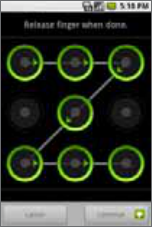
188 Managing your Phone
5. Draw the screen unlock pattern by connecting
at least four dots in a vertical, horizontal and/or
diagonal direction. Lift your finger from the
screen when finished.
Note You must slide your finger on the screen to
create the pattern and not touch individual
dots.
6. The phone records the pattern. Touch Continue.
7. When prompted, draw the screen unlock pattern
again, then touch Confirm.
Tip Clear the Use visible pattern check box, if you
do not want the unlock pattern to display on
the screen when you unlock it.
Note To change your unlock screen pattern, press HOME > MENU, then touch Settings
> Security > Change unlock pattern.
When you fail to draw the correct unlock pattern on the screen after five attempts,
you will be prompted to wait for 30 seconds before you can try again. If you forgot
your screen unlock pattern, touch Forgot pattern. You will be prompted to sign in
using your Google Account name and password, and create a new screen unlock
pattern before the Home screen displays.
Managing your Phone 189
10.3 Managing Memory
To see how much phone memory is available for use
1. Press HOME > MENU, then touch Settings.
2. Scroll down the screen, then touch SD card & phone storage. The available
phone memory is displayed in the Internal phone storage section.
To see the available storage card space
1. Press HOME > MENU, then touch Settings.
2. Scroll down the screen, then touch SD card & phone storage.
The total and available storage card space display in the SD card section.
To clear application cache and data
1Press HOME > MENU, and then touch Settings > Applications > Manage
applications.
2. In the Manage applications list, touch the application whose cache and/or
data you want to delete.
Tip Press MENU to bring up sort and filter options.
3In the Application info screen, touch Clear data and/or Clear cache.
To uninstall applications not from Android Market
You cannot uninstall applications that are preinstalled on the phone.
1Press HOME > MENU, and then touch Settings > Applications > Manage
applications.
2. On the Manage applications screen, touch the application you want to
uninstall.
3. On the Application info screen, touch Uninstall.
190 Managing your Phone
To free up more phone memory or storage card space
If your phone is running low on memory, try the following:
In Browser, clear all temporary Internet files and Browser history information.
See “Browser” in Chapter 6 for more information.
Uninstall downloaded programs from Android Market you no longer use.
See Chapter 9 for details.
10.4 Synchronizing Google Apps
Google Apps on your phone, such as Gmail/Google Mail, Calendar, and Contacts,
give you access to the same personal information (emails, events, and contacts)
that you add, view, and edit on your computer using Gmail/Google Mail or
Calendar. Synchronize the Google Apps you want to keep information up-to-date.
To select which application to synchronize
Press HOME > MENU.
Touch Settings > Data synchronization > Data synchronization.
Note By default, all personal information in Gmail/Google Mail, Calendar, and Contacts
will sync whenever you make a change or receive a new message.
•
•
1.
2.
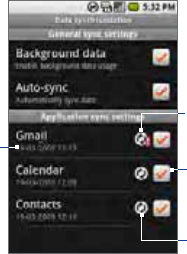
Managing your Phone 191
Date and time of
last synchronization Touch to include or exclude
the application from
automatic synchronization.
The arrows move clockwise
when data is being
synchronized.
Indicates that there is
a problem with data
synchronization. Check
your data connection and
try again.
3. Select the Google Apps you want to synchronize.
Tip Select Auto-sync to automatically synchronize all applications. When Auto-sync is
disabled, you can synchronize individual applications manually by selecting their
respective check boxes.
To stop synchronization
During synchronization, press MENU, then touch Cancel sync to stop
synchronization.
192 Managing your Phone
10.5 Resetting the Phone
Resetting the phone deletes all data, including downloaded applications, and
resets the phone back to its initial state—the state before you turned on the phone
for the first time.
Important Make sure to back up important data you have on the phone before you
perform a factory data reset.
To reset the phone
1. Press HOME > MENU, then touch Settings.
2. Scroll down the screen, then touch SD card & phone storage.
3. Navigate to the Internal phone storage section, then touch Factory data
reset.
4. On the Factory data reset screen, touch Reset phone and then touch Erase
everything.
To perform a factory data reset using phone buttons
1. With the phone turned off, press and hold the HOME and END CALL/POWER
buttons until you see the screen with an exclamation point image.
2. Press the HOME and SEND buttons.
Tip If your phone hangs or freezes, remove the battery then wait for a few seconds, and
then re-install it. After re-installing the battery, turn on the phone.
Appendix
A.1 Specifications
A.2 Regulatory Notices

194 Appendix
A.1 Specifications
Processor Qualcomm® MSM7201A™ 528 MHz
Platform Android™
Memory ROM: 512 MB
RAM: 192 MB
Dimensions (LxWxT) 113 x 55.56 x 13.65 mm (4.45 x 2.19 x 0.54 in)
Weight 116 g (4.09 ounces) with battery
Display 3.2-inch TFT-LCD touch-sensitive screen with 320 x 480
HVGA resolution
Network HSPA/WCDMA:
900/2100 MHz
Up to 7.2 Mbps down-link and 2 Mbps up-link speeds
Quad-band GSM/GPRS/EDGE:
850/900/1800/1900 MHz
(Band frequency, HSPA availability, and data speed are operator
dependent)
•
•
•
Device Control Trackball with Enter button
GPS Internal GPS antenna
Connectivity Bluetooth® 2.0 with Enhanced Data Rate and A2DP for wireless
stereo headsets
Wi-Fi®: IEEE 802.11b/g
HTC ExtUSB™ (11-pin mini-USB 2.0 and audio jack in one)
•
•
•
Camera 3.2 megapixel color camera with auto focus
Audio Supported
Formats
AAC, AAC+, AMR-NB, MP3, WMA, WAV, AAC-LC, MIDI, OGG
Video Supported
Formats
MP4, 3GP

Appendix 195
Battery Rechargeable Lithium-ion battery
Capacity: 1340 mAh
•
•
Talk time: Up to 400 minutes for WCDMA
Up to 450 minutes for GSM
Standby time: Up to 660 hours for WCDMA
Up to 420 hours for GSM
(The above are subject to network and phone usage.)
•
•
Expansion Slot microSD™ memory card (SD 2.0 compatible)
AC Adapter Voltage range/frequency: 100 - 240V AC, 47/63 Hz
DC output: 5V and 1A
Special Features Digital Compass, G-Sensor
Note Specifications are subject to change without prior notice.
A.2 Regulatory Notices
Regulatory Agency Identifications
For regulatory identification purposes, this product is assigned a model number of
HT-03A
To ensure continued reliable and safe operation of this product, use only the
accessories listed below with your HT-03A.
The Battery Pack has been assigned a model number of SAPP160.
Note This product is intended for use with a certified Class 2 Limited Power Source, rated 5
Volts DC, maximum 1 Amp power supply unit.
Note THE MANUFACTURER IS NOT RESPONSIBLE FOR ANY RADIO OR TV INTERFERENCE
CAUSED BY UNAUTHORIZED MODIFICATIONS TO THIS EQUIPMENT. SUCH
MODIFICATIONS COULD VOID THE USER’S AUTHORITY TO OPERATE THE EQUIPMENT.
European Union Notice
Products with CE marking comply with the R&TTE Directive (99/5/EC), the EMC
Directive (204/108/EEC), and the Low Voltage Directive (2006/95/EC) issued by the
Commission of the European Community.
196 Appendix
Compliance with these directives implies conformity to the following European
Norms (in parentheses are the equivalent international standards).
EN 60950-1 (IEC 60950-1)
Safety of Information Technology Equipment.
ETSI EN 300 328
Electromagnetic compatibility and Radio spectrum Matters (ERM); Wideband
Transmission systems; data transmission equipment operating in the 2.4 GHz
ISM band and using spread spectrum modulation techniques.
EN 300 440-2 V1.1.2
Electromagnetic compatibility and Radio spectrum Matters (ERM); Short
range devices; Radio equipment to be used in the 1 GHz to 40 GHz frequency
range; Part 2: Harmonized EN under Article 3(2) of the R&TTE Directive.
EN 301 489-24
Electromagnetic compatibility and Radio spectrum Matters (ERM);
Electromagnetic Compatibility (EMC) standard for radio equipment and
services; Part 24: Specific conditions for IMT-2000 CDMA direct spread (UTRA)
for mobile and portable (UE) radio and ancillary equipment.
ETSI EN 301 511
Global system for mobile communications (GSM); Harmonized EN for
mobile stations in the GSM 900 and GSM 1800 bands, covering essential
requirements of article 3.2 of the R&TTE directive (1995/5/EC).
ETSI EN 301 489-1
Electromagnetic compatibility and Radio spectrum Matters (ERM);
Electromagnetic Compatibility (EMC) standard for radio equipment and
services; Part 1: Common technical requirements.
•
•
•
•
•
•
Appendix 197
ETSI EN 301 489-7
Electromagnetic compatibility and Radio spectrum Matters (ERM);
Electromagnetic Compatibility (EMC) standard for radio equipment and
services; Part 7: Specific conditions for mobile and portable radio and
ancillary equipment of digital cellular radio telecommunications systems
(GSM and DCS).
ETSI EN 301 489-17
Electromagnetic compatibility and Radio spectrum Matters (ERM);
Electromagnetic Compatibility (EMC) standard for radio equipment and
services; Part 17: Specific conditions for 2.4 GHz wideband transmission
systems.
ETSI EN 301 908-1 & -2
Electromagnetic compatibility and Radio spectrum Matters (ERM); Base
Stations (BS), Repeaters and User Equipment (UE) for IMT-2000 Third
Generation cellular networks; Part 1: Harmonized EN for IMT-2000,
introduction and common requirements, covering essential requirements of
article 3.2 of the R&TTE Directive.
EN 62209-1
Human exposure to radio frequency fields from hand-held and body-
mounted wireless communication devices - Human models, instrumentation,
and procedures -- Part 1: Procedure to determine the specific absorption
rate (SAR) for hand-held devices used in close proximity to the ear (frequency
range of 300 MHz to 3GHz).
EN 50392
Generic standard to demonstrate the compliance of low power electronic and
electrical apparatus with the basic restrictions related to human exposure to
electromagnetic fields (10 MHz - 300 GHz) - General public.
•
•
•
•
•

198 Appendix
EN 301 489-3
Electromagnetic compatibility and Radio spectrum Matters (ERM);
ElectroMagnetic Compatibility (EMC) standard for radio equipment and
services; Part 3: Specific conditions for Short-Range Devices (SRD) operating
on frequencies between 9 kHz and 40 GHz.
EN 50360
Product standard to demonstrate the compliance of mobile phones with the
basic restrictions related to human exposure to electromagnetic fields (300
MHz – 3 GHz).
This equipment may be operated in:
AT BE BG CH CY CZ DE DK
EE ES FI FR GB GR HU IE
IT IS LI LT LU LV MT NL
NO PL PT RO SE SI SK TR
Safety Precautions for Radio Frequency Exposure
Use only original manufacturer-approved accessories, or accessories that do not
contain any metal.
Use of non-original manufacturer-approved accessories may violate your local
Radio Frequency exposure guidelines and should be avoided.
•
•
Appendix 199
Exposure to Radio Frequency (RF) Signals
Your phone contains a radio transmitter and receiver. The radiated output power
is far below the international radio frequency exposure limits. These limits are part
of comprehensive guidelines and establish permitted levels of Radio Frequency
energy for the general population. The guidelines are based on the safety
standards previously set by international standards bodies:
American National Standards Institute (ANSI) IEEE. C95.1-1992
National Council on Radiation Protection and Measurement (NCRP).
Report 86. 1986
International Commission on Non-Ionizing Radiation Protection (ICNIRP) 1996
Ministry of Health (Canada), Safety Code 6. The standards include a
substantial safety margin designed to assure the safety of all persons,
regardless of age and health.
The exposure standard for wireless mobile phones employs a unit of measurement
known as the Specific Absorption Rate, or SAR. The standard incorporates a
substantial margin of safety to give additional protection for the public and to
account for any variations in usage.
As with other mobile radio transmitting equipment, users are advised that for
satisfactory operation of the equipment and for the safety of personnel, it is
recommended that no part of the human body be allowed to come too close to
the antenna during operation of the equipment.
Your phone has an internal antenna. Use only the supplied integral antenna. Use
of unauthorized or modified antennas may impair call quality and damage your
phone, causing loss of performance and SAR levels exceeding the recommended
limits as well as result in non-compliance with local regulatory requirements in
your country.
To assure optimal phone performance and ensure human exposure to Radio
Frequency energy is within the guidelines set forth in the relevant standards;
always use your phone only in its normal-use position. Do not touch or hold the
antenna area unnecessarily when placing or receiving a phone call. Contact with
•
•
•
•
200 Appendix
the antenna area may impair call quality and cause your phone to operate at a
higher power level than needed. Avoiding contact with the antenna area when
your phone is IN USE optimizes the antenna performance and the battery life.
Body-worn measurements were tested for typical body-worn operations with the
back of your phone kept 1.5 cm from the body.
SAR Information
1.39 W/kg @ 10g (Head)
1.38 W/kg @ 10g (Body)
Telecommunications & Internet Association (TIA)
Safety Information
Pacemakers
The Health Industry Manufacturers Association recommends that a minimum
separation of six inches be maintained between a handheld wireless phone
and a pacemaker to avoid potential interference with the pacemaker. These
recommendations are consistent with the independent research by and
recommendations of Wireless Technology Research. Persons with pacemakers:
Should ALWAYS keep your phone more than six inches from their pacemaker
when your phone is turned on.
Should not carry your phone in a breast pocket.
Should use the ear opposite the pacemaker to minimize the potential for
interference. If you have any reason to suspect that interference is taking place,
turn your phone off immediately.
Hearing Aids
Some digital wireless phones may interfere with some hearing aids. In the event of
such interference, you may want to consult your wireless service provider, or call
the customer service line to discuss alternatives.

Appendix 201
Other Medical Devices
If you use any other personal medical device, consult the manufacturer of your
phone to determine if they are adequately shielded from external Radio Frequency
energy. Your physician may be able to assist you in obtaining this information.
Turn the phone off in health care facilities when any regulations posted in
these areas instruct you to do so. Hospitals or health care facilities may be using
equipment that could be sensitive to external Radio Frequency energy.
WEEE Notice
The Directive on Waste Electrical and Electronic Equipment (WEEE), which entered
into force as European law on 13th February 2003, resulted in a major change in
the treatment of electrical equipment at end-of-life.
The purpose of this Directive is, as a first priority, the prevention of WEEE, and
in addition, to promote the reuse, recycling and other forms of recovery of such
wastes so as to reduce disposal.
The WEEE logo (shown at the left) on the product or on its box indicates that this
product must not be disposed of or dumped with your other household waste. You
are liable to dispose of all your electronic or electrical waste equipment by relocating
over to the specified collection point for recycling of such hazardous waste. Isolated
collection and proper recovery of your electronic and electrical waste equipment
at the time of disposal will allow us to help conserving natural resources. Moreover,
proper recycling of the electronic and electrical waste equipment will ensure safety of
human health and environment. For more information about electronic and electrical
waste equipment disposal, recovery, and collection points, please contact your local
city centre, household waste disposal service, shop from where you purchased the
equipment, or manufacturer of the equipment.
RoHS Compliance
This product is in compliance with Directive 2002/95/EC of the European
Parliament and of the Council of 27 January 2003, on the restriction of the use of
certain hazardous substances in electrical and electronic equipment (RoHS) and its
amendments.
202 Appendix
Index
Symbols
3G 120
A
Add an Exchange ActiveSync account 108
Airplane Mode 60
Alarm
- set an alarm 86
Alarm Clock 86
Android Market 176
- nding applications 177
- getting help 177
- installing an application 178
- managing applications 180
- uninstalling an application 180
Applications
- on your phone 46
- tab 46
B
Back cover
- remove 25
Backlight
- adjust brightness 183
Basic settings 182
Battery 25, 27
- charge battery 30
- install 28
- remove 28
Bluetooth
- about 131
- disconnect 133
- modes 131
Bookmarks 130
- a web page 130
- edit 130
- open 130
Browser 123
- open 123
- to nd text 127
C
Calendar 82
- create events 82
- open 82
Calendar views 83
Call Log 58
- clear 59
Call settings
- adjust the call settings 60
Camcorder 150
Camera 150
- capture modes 151
- menu panel 154
- Review screen 153
- shoot videos 152
204 Index
Chat
- close 114
- sign out 117
- switch chats 114
Compact QWERTY 75
Connect phone to Internet
- ways of connecting 120
Contact
- send an email 68
Contact details 67
Contacts 61
- add new 62
- call 67
- edit 66
- send a text or picture message 67
D
Data roaming 185
Date 182
Dialer 52
Display settings 183
Downloads 128
E
E-mail
- create and send 100
- open 102
- receive and read 102
- search 103
EDGE 120
Emergency call 53
Events
- create 82
Extended Home screens 38
External email accounts
- add 106
- adjust the settings 110
- compose and send emails 108
- delete a message 110
- delete an account 110
- sort 109
F
Folders 39
Friends list 114
- nd 114
- pin 115
G
Gallery
- about 155
Getting around your phone 32
Gmail (Google Mail) 99
- create and send emails 100
- open 99
Google password 36
Google Talk 111
- add a friend 112
- change the settings 116
- change your status 113
- friends list 114
- sign in automatically 117
- sign out 117
- view and accept invitations 112
GPRS 120
GPS satellites 136
Index 205
H
Home page 124
Home screen
- about 37
- customize 39
- extended Home screens 38
HTC Sync 69
- advanced options 71
- install 69
- set up 69
- synchronize contacts 70
I
Inside the box 24
Internet 120
L
Language settings 185
Links 128
Location source 136
M
Mail 106
Making Calls 52
Map mode 140
- Map mode 140
- Satellite mode 140
- Street View 141
- Trac mode 141
Maps
- about 136
- nd your location 136
- location source 136
- navigate 139
- open 136
- search 137, 139
- view 139
- zoom in or out 139
Memory 189, 194
Memory card
- install 29
- remove 29
- remove while the phone is on 49
Message draft 95
Message signature 101
Message threads 95
- delete 97
- open 95
Messaging 90
- open 90
Microsoft Exchange ActiveSync 108
Missed call 59
MMS settings 98
Mobile indicators 116
Music
- delete music on memory card 170
- Music Library 166
- open 166
- playback screen 167
- playlists 168
- play music 167
- set as ring tone 170
- supported le formats 165
Music Library 166
Mute the microphone 55
206 Index
N
Notification LED 45
Notification ring tone 184
Notifications Panel 44
O
Onscreen keyboard 74
- Compact QWERTY 75
- Phone keypad 76
- QWERTY 74
P
PDF Viewer 171
Phone controls 31
Phone keypad 76
Phone services 185
Phone views
- back panel 23
- bottom panel 24
- front panel 22
- left panel 23
Picture message 90
- reply 96
- settings 98
- view 96
PIN 34, 186
Playlists
- about 168
- create 168
- manage 168
Q
Quickoffice 172
QWERTY 74
R
Regulatory notices 195
Ringer settings 184
Ring tone 170
- change 184
Roaming 185
S
Safety information 4
Screen lock 187
Screen unlock pattern 187
Settings 47
Shortcut 39
SIM card 25
- install 26
- PIN 186
- remove 26
SMS settings 98
Speakerphone 56
Specifications 194
Status icons 41
Synchronizing Google Applications 190
T
Take pictures 151
Text message 90
- create and send 91
- reply 96
- settings 98
Index 207
Text settings 78
Time 182
Time zone 182
Touch tones 184
Trackball 33
Turn off the display 36
Turn phone function on and off 60
Turn power on and off 34
U
USB drive 49
V
Videos 163
Voice call
- answer call 54
- end call 57
Volume
- adjust 48
- media volume 48
- ringer volume 48
W
Wallpaper 39, 40
Web applications 129
Web history 128
Web page
- go to a web page 124
- navigate 125
- set your home page 124
- view multiple pages 126
- zoom in or out 126
Web pages
- view 124
Wi-Fi 121
Widget 39
Y
YouTube
- about 162
- open 163
- search videos 164
- share videos 164
- watch videos 163
208 Index